
Navigation Lights for Sailboats (And How To Read Them)

Last Updated by
Capt Chris German
June 15, 2022
Navigation lights on a sailboat can be confusing. If you understand the reason behind why they are the way they are however, they can make a lot more sense.
At their heart, sailboats are really just a power boat and as such must adhere to all power boat rules such as navigation lights. Other times however, a sailboat is classified in a special category. They have a set of additional lights they CAN show as an option, but are not always required to do so.
That’s about as clear as mud if you ask me and I contend that that is where the confusion about lighting a sailboat begins.
Just because you can show a light to identify yourself in times of low visibility, does not mean you have to and then we add in a little sibling rivalry between power and sail and things get downright adversarial when it comes to navigation and the night.
Table of contents

The USCG says You’re a Power Boat Whether You Like It or Not
Much to the consternation of many a sailor who has earned a commercial license to drive their sailboat, when you received your credential from the USCG it says you are a master of steam and power across the top with no mention of wind as a source of propulsion.
It is not until you read the back pages of your little red book that feels like a passport and looks like a US Sailing credential, that you will see the term “sail auxiliary”. That is because most of the time the U.S. Coast Guard knows that you are primarily reliant on your mechanical power to propel your vessel.
It's a sad thing, but the days of commercially viable sail boats are done and all but the most select few even have sails let alone use them as their primary power source. All sail boats by law are powerboats, but not all powerboats are sailboats.
Navigation Lights for a Power Boat
As a power boat, you are required to show certain lights and have been required to do so before power was even invented.
In the days of man powered vessels like the viking ships who relied on oars while in close quarters to power their vessels, they needed to show other boats, friend or foe, where they were by showing lanterns in the dark to identify themselves. As you know, it is a time honored rule among all the nations of the world both past and present, that you must avoid a collision at all costs while at sea and even the viking knew that you should not run into things.
By lighting the front and back of your boat, you could warn other boats of your presence as well as identify which way you were heading. As such there is a very specific rule in the Code of Federal Regulations Number 46 (CFR46 by common name) that spells out with detail how many, the color, the luminosity or brightness, the angle of visibility and the location of all of the lights required for navigation on every single boat, seaplane, submarine and other nondescript vessel conceived by man to date that they must show while underway in reduced visibility.
And there is no flexibility in the rules.
As such a power boat, and by extension all sailboats, MUST, without question show one green light on the starboard bow and one red light on the port bow and one all around white light or lights while operating in reduced visibility. These lights should shine at all 360 degrees of visibility with the bow lights shining at an angle of dead ahead to 22.5 degrees abaft the beam and the stern lights shining 225 degrees dead aft. A forward facing masthead light that is white in color shall shine forward to comply with the directive that all vessels must carry an all around white light. For more read here .
As you can see, there isn’t much wiggle room when it comes to lights that must be shown.
Sailboats get a little flexibility with lights
Sailboats however, are a little different when they are in fact sailboats, which is only when you are entirely reliant on the wind for power and in no way reliant on any mechanical or manual means of propulsion. And for good reason.
Back in the day when men were men and sailboats were wooden, fire was a major concern. Sails were coated with wax and other flammable substances and the wood on boats was saturated with oils and grease. Even the ropes were plant materials saturated with oils to keep them pliable and strong.
Add those highly flammable substances to a parching environment like the sea and you had what was essentially a giant floating tinderbox.
Then tell that giant floating tinderbox that they need to identify themselves to the world at large at night using oil lamps with flames because batteries and lights were not invented yet. It didn't take very long or very many ships burning to the water line for the Governments to say to the sailboats, you get to do things a little different.
As such, sailboats are given special dispensation when it comes to lights aloft. They don't have to show an all around white light in their rigging because no one wanted to set their rig on fire with oil lamps 60 feet up in their rig.
However, when a sailboat takes their sails down such as when they are powered or at anchor, they must resume the display of an all around white light or lights aloft. That became a real challenge with aluminum masts and the disappearance of rat lines on the shrouds because there was no easy way to climb the rig and check the bulbs up the mast on a regular basis.
Red over Green Sailing Machine
I have no idea where the history of this particular light comes from, but if you ever take a deck exam with the USCG, you better remember this mnemonic. An all around red light over an all around green may be displayed on a vessel during times of reduced visibility to indicate that a vessel is operating under sail power alone.
I won’t even speculate on how or why they came up with this particular light configuration, but if you want to use these lights as a sailing vessel, you can do so, but that means that you will need three all round lights at the top of your mast, an all around white, an all around red and an all around green, just in that order.
The red over green is to be displayed in addition to the running lights or the red and green bow lights with the 225 degree stern light. As always, when the motor comes on, so does the steaming light or the forward facing white light that is also usually about ¾ of the way up on your mast to complete the requirement of an all around white light that indicates a power vessel.
What is a “steaming light” and why are you mentioning it now?
Most sailboat electrical panels will have a switch that is labelled “steaming light” and it will only come on when your anchor light is off. This is probably the most confusing part of sailboat navigation lights so if you are confused about this, you're in good company as most people are.
A “steaming” light is named thusly, going back to the days of steam powered sailboats where when they fired up their boilers and doused the sails, they became a power boat once again. There aren’t too many steam powered boats, let alone steam powered sailboats, but the name stuck and it is a vestige of a bygone era.
Either way, when you fire up your motor, you turn on your “steaming light” and that locks out the all around white light which is used for anchoring to minimize the number of switches on your panel and reduce the number of wires in your mast. The fewer wires, the less chance of something not working or becoming disconnected.
The steaming light and the anchor light both go up the mast, but you can’t use an all around white light while using the 225 degree stern light at the deck level because to other boaters you would look like you have two white lights from the stern and that would be confusing.
The anchor light is used exclusively for anchoring while the steaming light is used to indicate you are a power vessel while underway.
As to why I am mentioning it now in the article, is because this would have blown your mind if I started with this subject cause it can be really confusing stuff.
Aspect Recognition with Lights
Remember when I said earlier that lights can help you tell others which way you are heading as well as tell you which way other boats are heading? That is called the aspect of the vessel and the USCG tests you on this for your deck exam as well.
Knowing that the bow lights go 22.5 degrees abaft the beam on both sides or 112.5 degrees on each side, and the stern light faces 225 degrees aft for a total of 360 degrees of visibility, you can tell a lot about where a boat is heading and who has the right of way.
One thing that's easy to remember is red means stop and if you see a vessel's red light, it means stop as you are the give way vessel and approaching the other vessel from his port side. Conversely it works with green as well as that means you are approaching from the other vessel's starboard side and you are the standon vessel.
If you see a red and green light equally low on the horizon, that means your heading dead on into another vessel's path and conversely if all you see is a white light low on the horizon, it means you are overtaking another vessel power or sail, we don’t care because it is an overtaking situation. However, any time you do see a white light aloft in addition to the red and green bow lights, you know you are encountering a power boat.
Then there are angular approaches as well, where you see white and red or white and green light low on the horizon. You know in that case you are seeing a portion of the bow lights and stern lights from the side approaches of a vessel. Based on which direction those lights are heading, you can deduce which way that boat is going in relation to your boat.
So put it all together and you see a green light and a white light low on the horizon with a red over green light aloft, you know that you are approaching a sailboat that is traveling to your port and that might make you the standon vessel. That is of course, if we didn’t concern ourselves with windward and leeward and port tacks and starboard tacks, but that is a discussion for another article. So stay tuned when we talk about sailing rules and the right of way. But for now, do good, have fun and sail far.
Related Articles
Capt Chris German is a life long sailor and licensed captain who has taught thousands to sail over the last 20 years. In 2007, he founded a US Sailing-based community sailing school in Bridgeport, CT for inner city youth and families. When Hurricane Sandy forced him to abandon those efforts, he moved to North Carolina where he set out to share this love for broadcasting and sailing with a growing web-based television audience through The Charted Life Television Network.
by this author

Most Recent

What Does "Sailing By The Lee" Mean?
Daniel Wade
October 3, 2023

The Best Sailing Schools And Programs: Reviews & Ratings
September 26, 2023
Important Legal Info
Lifeofsailing.com is a participant in the Amazon Services LLC Associates Program, an affiliate advertising program designed to provide a means for sites to earn advertising fees by advertising and linking to Amazon. This site also participates in other affiliate programs and is compensated for referring traffic and business to these companies.
Similar Posts

How To Choose The Right Sailing Instructor
August 16, 2023

Cost To Sail Around The World
May 16, 2023

How To Drive A Pontoon Boat
Jacob Collier
December 19, 2022
Popular Posts

Best Liveaboard Catamaran Sailboats
December 28, 2023

Can a Novice Sail Around the World?
Elizabeth O'Malley

4 Best Electric Outboard Motors

How Long Did It Take The Vikings To Sail To England?

10 Best Sailboat Brands (And Why)
December 20, 2023

7 Best Places To Liveaboard A Sailboat
Get the best sailing content.
Top Rated Posts
Lifeofsailing.com is a participant in the Amazon Services LLC Associates Program, an affiliate advertising program designed to provide a means for sites to earn advertising fees by advertising and linking to Amazon. This site also participates in other affiliate programs and is compensated for referring traffic and business to these companies. (866) 342-SAIL
© 2024 Life of Sailing Email: [email protected] Address: 11816 Inwood Rd #3024 Dallas, TX 75244 Disclaimer Privacy Policy

Navigation Lights
- You are required to display the appropriate lights at night or during times of reduced visibility.
Navigation lights are used to prevent collisions at night or in times of reduced visibility, and are an essential tool in keeping you and your vessel safe. Nav lights allow you to see other nearby vessels, and allow other vessels to see you.
Nav lights also provide information about the size, activity, and direction of travel. By understanding the characteristics of Nav lights, you can determine an appropriate course of action as you approach another vessel.
On any vessel, navigation lights have a specific color, (white, red, green, yellow, blue), arc of illumination, range of visibility, and location, as required by law and regulations. For the purposes of this course, we will concentrate on pleasure boats under 65 feet in length. Knowledge of navigation lights is important to a small-boat skipper for separate, but important, reasons.
- You are legally responsible for displaying lights of the proper color, intensity, location and visibility on your boat.
- Knowing the type and heading of another boat.
Legal Requirements
Vessels are required to show the proper navigation lights from sunset to sunrise in all weather conditions, good and bad. During these times, no other lights that could be mistaken for lights specified in the Rules of the Road can be displayed, nor any lights that impair the visibility or distinctive character of navigation lights, or interfere with the keeping of a proper lookout. The Rules also state that navigation lights must be shown in conditions of reduced visibility, and may be shown at other times considered necessary.
It's Your Responsibility
It is the responsibility of the owner/operator of a vessel that she show the proper navigation lights for her size and the waters in which she is operating. It is not the responsibility of the manufacturer, importer, or selling dealer. Many boats are delivered with lights that do not meet legal requirements with respect to technical characteristics or placement on the vessel. Remember also, that the angles of visibility must be met when the boat is underway-if your boat rides at a significant bow-up angle, take that into consideration when installing and/or checking your lights.
Navigation Lights for Powerboats
Power driven vessels underway shall exhibit a masthead light forward, sidelights and a stern light. Vessels less than 12 meters in length may exhibit an all around white light and side lights. Power driven boats on the Great Lakes may carry an all around white light in stead of a second masthead light and stern light combination.

Sidelights - Colored lights - red on port and green on starboard - showing an unbroken arc of the horizon of 112.5 degrees, from dead ahead to 22.5 degrees abaft the beam on each side.
Combination lights - Sidelights may be combined in a single fixture carried at the centerline of the vessel.
Stern light - A white light showing over an unbroken arc of the horizon of 135 degrees, centered on dead astern.
Navigation Lights for Sailing
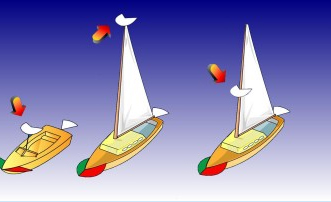
A sailing vessel of less than 7 meters in length shall, if practicable, exhibit regular navigation lights, but if not practical, she shall have ready at hand an electric torch or lantern showing a white light which shall be exhibited in sufficient time to prevent collision.
Diving Lights
Another light display that you may see in resort areas, or waters that have wrecks or reefs, is the night diving configuration. This has three vertical masthead lights, that have a red-white-red sequence. You must maintain a good distance from these vessels, and you should also be aware that there may be divers near you.
Interpreting what you see

It's great that you're learning the basics of lights - what is required and when they're required. But, this in only the beginning. You must also learn how to interpret the navigation lights that you see when you are underway at night- and for your safety-learn it well.
For instance, if you see a vessel approaching that shows a light pattern such as the ones to the right, you immediately know that you are in a crossing situation, and that you must yield to the other vessel - that's why it is red.

Seeing a green light over a white light indicates a fishing vessel actively trawling. You not only need to avoid the vessel, but you also need to remember that it could potentially have a very large net deployed that you will also need to avoid.
And there are numerous other lights and combinations of lights that you must be able to instantly recognize - the lights for a sailboat that is privileged over a motorboat, the special lights of various fishing vessels, a dredge or a vessel not under command. Study the requirements for navigation from the viewpoint of a "looker" as well as a boat owner.
Boat Navigation Lights Rules: Illustrated Beginners Guide
When navigating at night, the lights on other boats are your first clue about the moving dangers around you. And your navigation lights are your first line of safety in avoiding collisions in the dark, and they tell others vessels what you are and what you are doing. The rules sound complex, but with a little understanding you can get the basics for any situation.
So what are the basic navigation light rules? For most small vessels, motoring requires red and green (port and starboard) lights, and a white light visible in all directions around the boat. This is almost always a stern light and a masthead light on sailboats. Boats under sail require port and starboard lights, and a white stern light. Sailboats below sixty-five feet may show a tricolor light at the masthead instead of side and stern lights when sailing.
That's it, in a nutshell. There's a little more to it, as the rules change with different sizes and there are some specifics about angles of display for the colors. Identifying other ships at sea requires more study, but the basics are the same. And it's not much trouble to make sure you've always got the proper lights on your vessel.
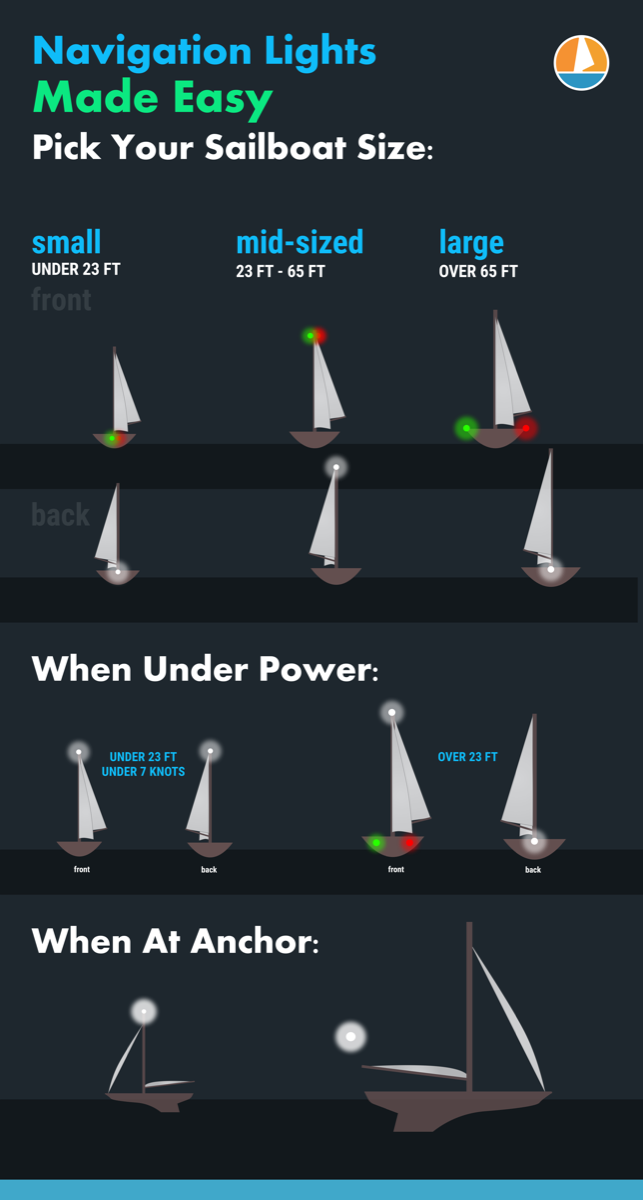
On this page:
What are the official colregs rules for your sailboat, what about the uscg (united states coast guard) rules, lighting at anchor, identifying the boats around you.
The International Regulations for the Prevention of Collision at Sea , abbreviated "COLREGS" is very specific about the lights required, their shapes and sizes, and the distance they must be visible. For the smaller boat, the following definitions apply.
- Masthead Light - a white light placed centerline on the boat showing an arc of 225 degrees with 112.5 degrees either side of the front of the vessel.
- Sidelights - A red light on the port side and a green light on the starboard. They must show an arc of 112.5 degrees from centerline of the bow.
- Stern light - A white light on the stern of the boat showing an unbroken arc of 135 degrees from centerline of the vessel.
- All-round light - A light showing in an unbroken arc of 360 degrees.
The good news is you need not measure these angles. Any properly installed USCG or COLREGS approved light which will cover the correct arcs. If you have to replace the original light from your boat, make sure it's with an approved replacement.
Lights When Sailing
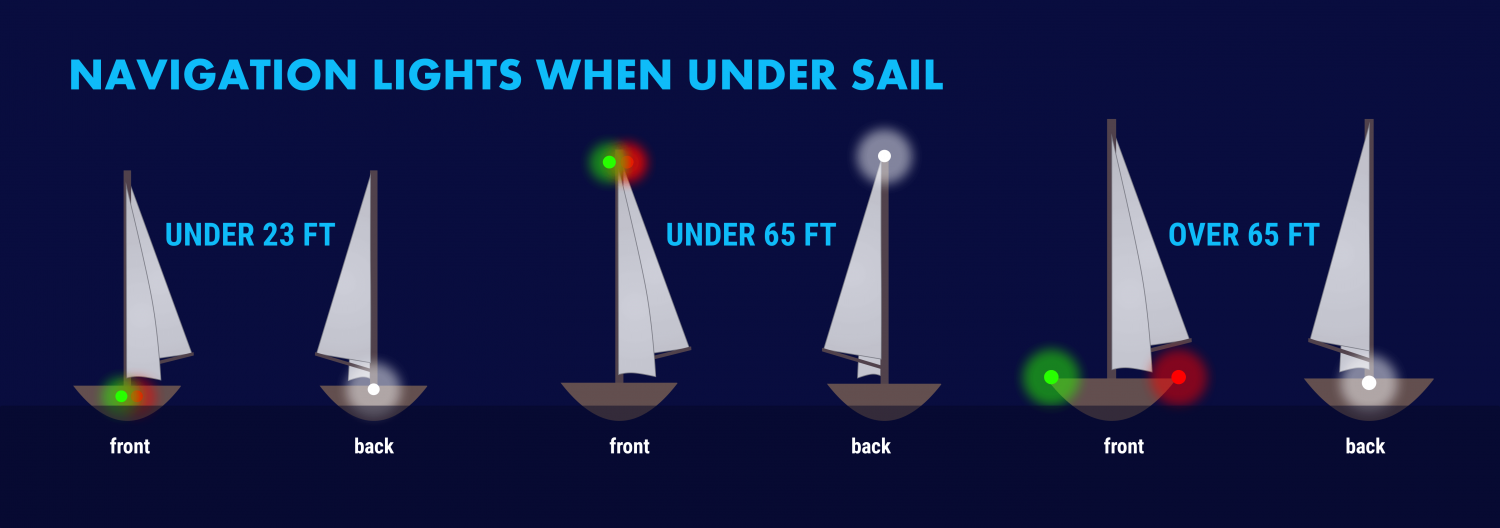
The specific rules for a sailboat under sail are in COLREGS Rule 25 and vary slightly with the size of the boat. A sailboat powering is considered a power boat and falls under in Rule 23.
- Under 23 feet (7 meters) - side lights and a stern light, possible. If these lights can not be displayed a light must be kept at hand to help avoid a collision. This can be a bright flashlight.
- Over 23 feet - Side lights visible to one nautical mile and stern light visible for two.
- Vessels under 65 feet may combine both sidelights into a single lantern on the bow.
- May show a tricolor light on the masthead instead of sidelights and a stern light. It's one or the other though, do not show these lights at the same time .
- Masthead light must be visible for three nautical miles, all other lights must have a two nautical mile visibility.
- Side lights must be separated.
- May not show a masthead tricolor light.
- Masthead light must have five nautical mile visibility, all other lights must be visible for two nautical miles.
- Optional masthead lights - any vessel under sail may display a red light over a green light at the masthead with sidelights and stern light. The red over green may NOT be displayed with a masthead tricolor light. It's one set or the other.
Lights When Motoring
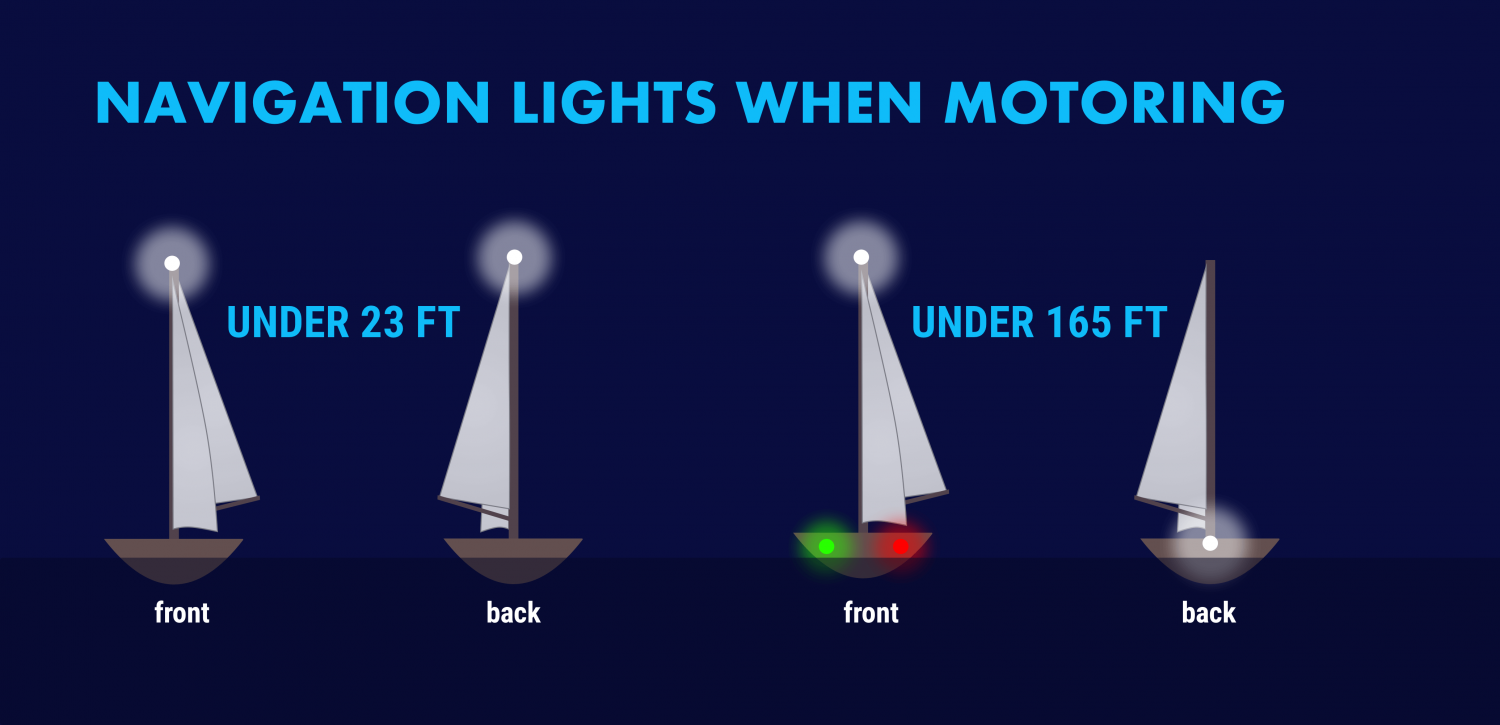
For all navigational purposes a sailboat under power is considered a power boat. This includes motor sailing - if the engine is on and providing propulsion you are on a power boat, even if the sails are up . This applies to navigation lighting, sound signals in fog and limited visibility, and rights of way.
Sailboats under 50 meters under power need to show:
- A masthead light
- Stern light
A power-driven vessel under 23 feet (7 meters) that does not exceed seven knots of speed may display an all around white light, though sidelights should be used if available.

The USCG has published its own "Rules of the Road" that are based on the COLREGS. In addition, it has rules for the "Inland Waterways" for rivers, inland lakes and the Great Lakes.
The good news is this has no impact on what you have to do with your own boat.
They mostly relate to lighting changes on towed vessels like barges and tugs. For example, a vessel towing or pushing another vessel in the ocean under COLREGS shows two masthead lights, sidelights and a stern light, whereas in Inland Waterways the towing or pushing vessel displays two yellow towing lights instead of a white stern light.
If you sail on lakes, rivers or the Great Lakes where towed commercial traffic is common you should learn the inland lights, but coastal or ocean sailors will never see these.
When you anchor outside a designated mooring field, you should display an all around white light at the masthead or as high in the boat as practical.
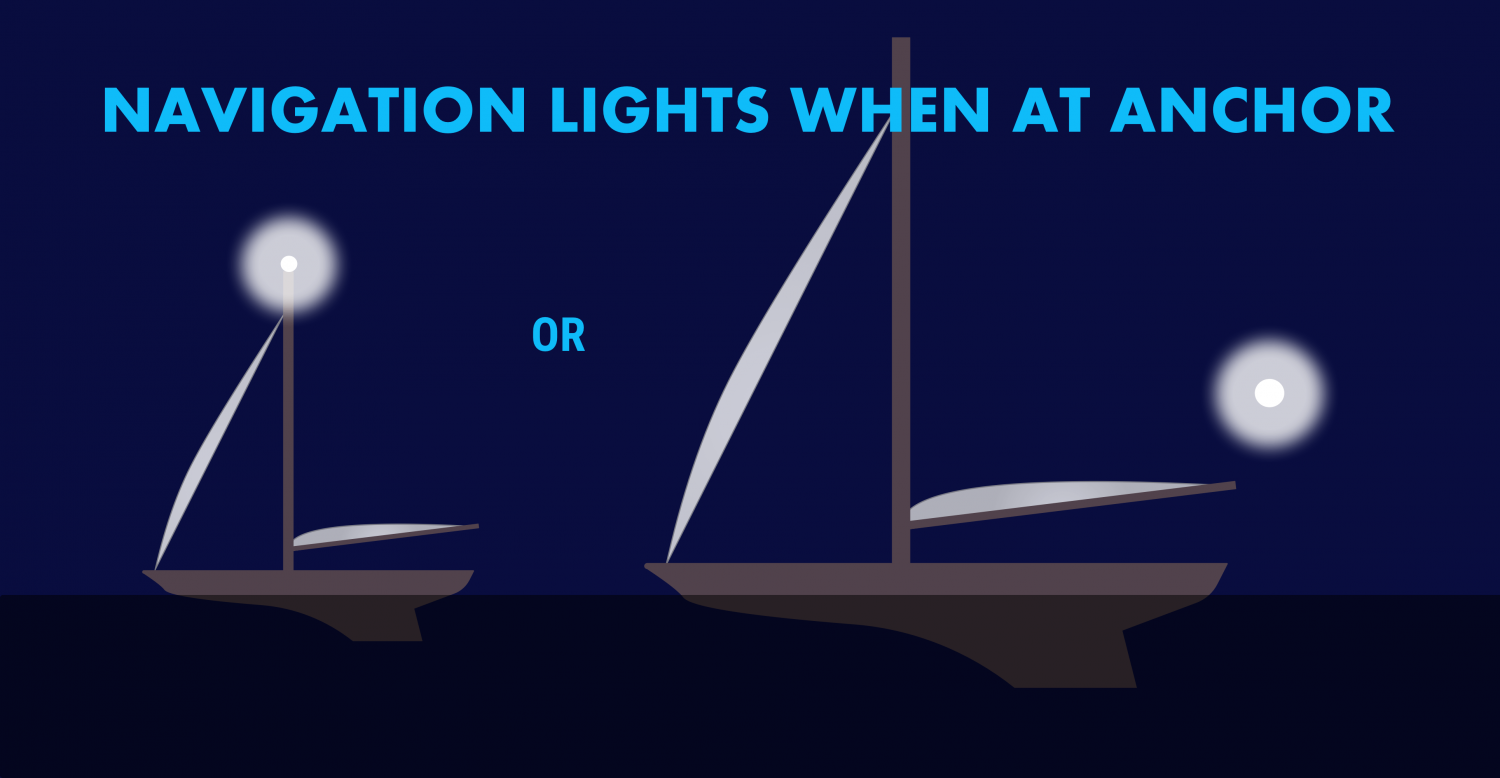
If your boat is large and has a very tall mast, you may wish to display another light closer to the waterline. Boats approaching in the dark may not see a light on a mast sixty or seventy feet in the air when they are close to your boat.
We use a simple garden path light on our stern when we anchor, left in a rod holder or flag socket. It comes on automatically at dusk and is a cheap and easy way to be more visible. There is no specific rule stating you can not display more lights than required, or the nature of any lights beyond the required all around light.
The COLREGS also specify that a round black "daymark" should be displayed in the rigging of any vessel at anchor. Very few small vessels observe this, however it is the correct display for a vessel in an anchorage.
If you tie to a mooring in a marked mooring area you are not required to display anchor lights, but there is no harm in doing so.
The other important reason to know your lights is to figure out what's going on around you at night. The water may be ablaze with white, red, green and other lights at night and they are your first key to avoiding collisions and problems.
All combinations of lights for fishing boats, commercial vessels, and so on are outside this post‘s scope. The odds are small you will encounter a submarine, seaplane or hovercraft at night, but there are regulations regarding specific lighting for each of those vessels!
There are a few fundamentals to help you figure out what that is you see on the horizon, which way it is going, and whether it is a danger to you.
Port Wine is Red
The fundamental rule is that red sidelights will ALWAYS be on the port side of a vessel, and green lights will always be on starboard. However, some vessels can use all around red and green lights for other purposes, though those will be higher than sidelights.

The light‘s on a ship is not important, some large tankers and freighters will have their sidelights far aft and put them on the superstructure for better visibility. It is not safe to assume that sidelights you can see are on the bow of large vessels .
When you can see the color, you know which way the bow is pointing. If it's red, it's pointing more or less to the left and will travel in that direction. A green light shows it is heading more or less to your right.
If you can see the red and green lights at the same time, you are looking directly at the bow of the vessel. When you are far away, this isn‘t as alarming as if you are close crossing. Seeing red and green lights together on a vessel is something you never want to see for long.
Be aware of red and green lights used in combination with other red, green and white lights. These may not be running lights and could have other significance.
Tankers, Freighters and Large Ships
Tankers, freighters and large ships will have side lights, a stern light and a masthead light. In addition, on vessels over 50 meters there will be a second masthead light further aft and higher than the forward light. The masthead light positions are a better tipoff to the bow direction and how far from the bow the sidelights might be. Remember - on a large vessel the sidelights may not be at the bow or even close to it.
USCG Inland Rules allow for a second all-around white light on large vessels on the Great Lakes instead of a second masthead light.
Fishing Boats
Fishing boats engaged in fishing will have more complex light displays. When they aren't fishing, they will show lights like any power vessel, but Rule 26 spells out light combinations that vary by the fishing activity being done. In general:
- Boats which are Trawling but not making headway will display a green all-around light over a white all-around light , and a masthead light aft of these lights. Boats making headway while trawling will show these lights, plus sidelights and a stern light.
- A vessel fishing other than trawling will show a red all-around light over a white all-around light . When making way they will also show sidelights and a stern light.
- If a vessel has gear more than 150 meters away from the boat, it will show a second all around light in the direction of the gear. The best rule is to give fishing boats as wide a berth as you can at night. They're easy to pick out if you check the top light configurations but their course may be difficult to predict.
Towing and Pushing
Towed vessels can be the most dangerous to cross, but they have the most lights to tell you what is happening. Refer to COLREGS or the USCG Rules of the Road Rule 24 for all combinations You can pick a tow/push vessel out with the following lights:
- Two or three masthead lights in a vertical line. Three masthead lights shows a tow over 200 meters. Additional masthead lights may show for larger tow vessels.
- A towing light (yellow light with the same characteristics as a stern light) directly above the stern light.
- The will also have side lights and a stern light.
- The towed vessel will show sidelights and a stern light. Lighting may vary under USCG inland rules, where towing lights may replace stern lights. Learn these differences if this is your regular cruising ground. If you think there is a tow ahead of you, always go well behind the aft most set of lights. Never go between a tow and avoid crossing ahead if possible as it may restrict their maneuverability.
Special Situations
There are several rare situations you may encounter. As a general rule, if there are a lot of lights and you don't understand them look for the sidelights on a moving vessel. If you can find them and figure out the direction it is moving, it makes the vessel easier to avoid. Stay well clear of lights you do not understand if you can avoid them without risk.
Most of these signals are used by larger, commercial vessels and you will not need them.
They use these light combinations with other light combinations. For example a towing vessel may also be restricted in maneuverability, and a vessel constrained by draft will show running lights if moving.
- Not Under Command - two all around red lights in a single line
- Restricted in Ability to Maneuver - red, white then red in a single line
- Constrained by draft - three all around red lights
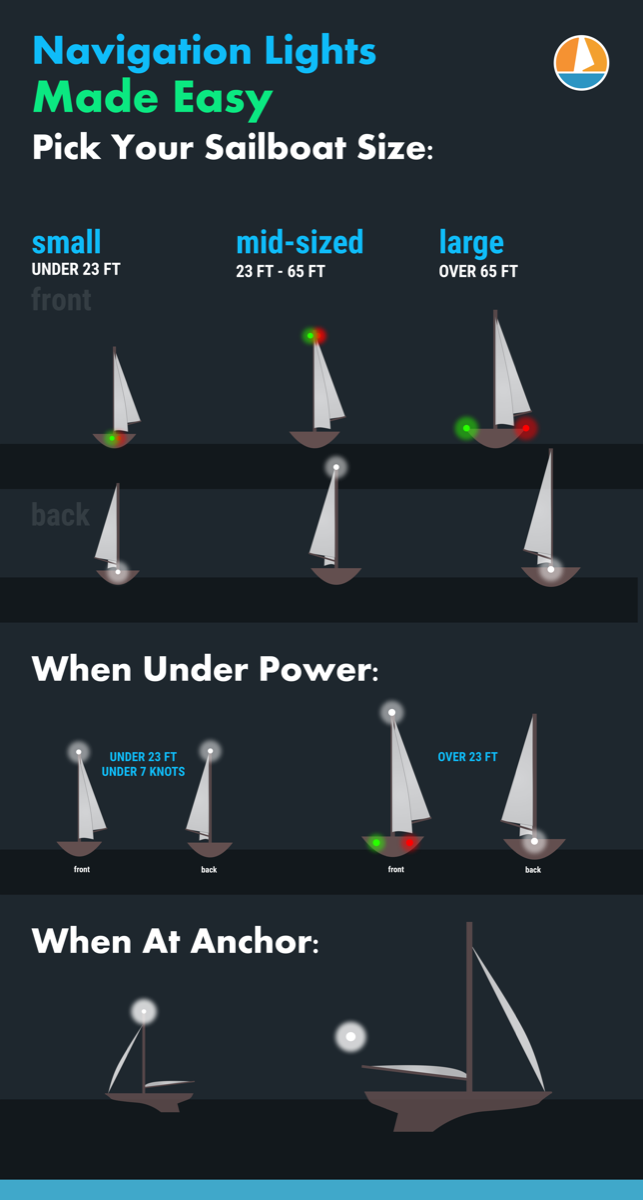
Leave a comment
You may also like, 17 sailboat types explained: how to recognize them.
Ever wondered what type of sailboat you're looking at? Identifying sailboats isn't hard, you just have to know what to look for. In this article, I'll help you.

The Ultimate Guide to Sail Types and Rigs (with Pictures)

Boat Navigation Lights: Everything You NEED to Know (2024)
In many cases, boating at night requires the use of boat navigation lights, but boaters often have many questions about them.
They often wonder when they’re needed, what the requirements are for various locations and vessels, and more.
We’re going to do a deep dive into navigation lights for boat to see what you need on your boat, and when you need to use them.
Legal Requirements
Types of navigational lights, which navigation lights are required on my boat , operators responsibility , navigation lights .
On any vessel operating on or in US waters, there is a need for the operator to display navigation lights under certain circumstances. Their purpose is to make vessels aware of each other at night or in times of generally reduced visibility. This is incredibly important during times when you may not be able to see the craft itself.
Other than visibility, marine nav lights also help boat operators determine the size, direction of travel, and even the potential activity of another boat on the water. When an operator understands the type of information each light tells them, they will be better able to determine appropriate courses of action for potential situations.
Boat running lights are divided by location and color, and each of them has specific requirements with how they must be displayed and perceived. You are the one legally responsible for displaying proper nav lights on the boat, for displaying them at the proper times, and for understanding how to read them.
The US Coast Guard ’s legal navigation light requirements include guidelines for every aspect of light usage.
Their materials start by first defining the standard daily period during which they must be used, then they detail how many of each type of light is needed as well as where they are located. Each light also has constraints regarding its visible distance and the arc over which it can be seen.
In the US, the Coast Guard says that any powered vessel that is under 39.4ft., may operate with boat nav lights in as little as two positions, an all-round light at the stern, and a set of sidelights at the bow.
Vessels that are under 164ft. must have lights displayed in four positions, a stern light, a masthead light, and boat sidelights on both the port and starboard, near the bow.
The ship navigation lights also have minimum visibility distances, depending on the size of the craft. The minimum visibility for nav lights, even for small crafts, is one mile, with requirements that other lights on larger vessels be visible for up to 3 nautical miles.
Also read: Boating Rules and Etiquette On the Water
Boat lights come in 4 types, sidelights, stern light, masthead light, and all-round light. Lights only come in white, red, and green, and all have very specific jobs.
| White | Over fore and aft centerline of the boat | 2 miles | 5 miles | 225 degrees | |
| Red | On the port side, 22.5 degrees abaft the beam | 1 mile | 2 miles | 112.5 degrees | |
| Green | On the starboard side, 22.5 degrees abaft the beam | 1 mile | 2 miles | 112.5 degrees | |
| White | Near as possible to the stern | 2 miles | 2 miles | 135 degrees | |
| White, Yellow, Tricolor | N/A | 2 miles | 2 miles | 360 degrees | |
| Green, Red, White | Over fore and aft centerline of the boat | N/A | N/A | 360 degrees | |
| Two White Vertical, Three White Vertical | Over fore and aft centerline of the boat | 2 miles | 2 miles | 135 degrees | |
| Flashing Blue | Anywhere not interfering with other lights | 2 miles | N/A | 180-225 degrees |
Masthead Light
The masthead light is the white light located about ⅔ of the way up the mast, rather than at the top as you’d think. This boat bow light is required when using motor power at night. To be acceptable, the light must have an arc of 225° and needs to be seen from 2 miles away.
Large boats can have up to 3 mast lights. If your boat is shorter than 39 ft., all 2-3 white mast lights can be combined, utilizing one larger white light at the top of the mast.
Color : White ARC : 225 degrees Position : Front of boat
Port Sidelight
The boating lights located on the port side of the watercraft are red and mounted so that boats can see as they approach either head-on or from the left. This light helps tell if a boat is coming towards you or if it is pointing away. The phrase “red, right, returning” means that if you see a boat with their red navigation light on the right, they are facing your boat. The only time it is not needed is when your boat is anchored for the night .
Color : Red ARC : 122.5 degrees Position : Forward, left side
Starboard Sidelight
If you are to approach a boat from the front or right, you will see the green starboard sidelight. With an ARC of 122.5 degrees, approaching boats will be able to see yours easily.
This light helps tell you whether or not you have the right of way, which is important when it comes to keeping both you and your passengers safe. These are some of the front boat lights.
This light will often be combined with the port light, in small boat navigation lights. When out in the water, if you see the green light, that means it is safe for you to go, as you have the right of way.
Color : Green ARC : 122.5 degrees Position : Forward, right side.
The rear boat light is called the stern light. It is used to mark the rear of the boat. The operator can infer from only setting a boat stern light, that they are directly behind the vessel.
The stern light is white and is visible for an arc of 112.5 degrees on both the port and starboard sides, making a full arc of 225. Being able to see the red starboard side light as well as the stern light, should indicate the other vessel is traveling to the right from the perspective of the observer.
Color : White ARC : 225 degrees Position : Stern
All-Around Light
One of the boat night lights that is required when on your boat between sunset and sunrise is the all-around light. This light is intended to be seen from any point and helps to tell what direction a boat is moving. This light is also used when a boat is stopped or anchored.
This anchor light is required to have an ARC of 360 degrees and should be visible for two miles. The all-around light is white and it is located at the top of your boat’s mast for maximum visibility.
Color : White ARC : 360 degrees Position : Top of mast
Tricolor Light
A tricolor light is a sailboat mast light that has your three types of bow light in one convenient piece of equipment. They are for sailboats that are smaller than 65.6 feet long. The point of this sailboat light is to increase your nighttime visibility. They are mounted at the top of the mast, allowing larger boats to see yours better. They are not permitted to be used by any boats with a motor. The only type of boat that can utilize a tricolor light is a sailboat.
Color : White, red, green ARC : 360 degrees Position : Top of mast
Towing Light
These yellow lights are important, as they indicate to other watercraft that, not only is there another boat nearby but that they are also towing someone as well. The light must be positioned at the back of the boat, as close to the stern as possible. The goal is to avoid having anyone run into the boat that is being towed, as there may be no lights showing where that boat is located. The boat lighting requirements when towing state that both sidelights, a stern light, and masthead lights should also be displayed.
Color : Yellow ARC : 135 degrees Position : Over fore and aft centerline of the boat
Law Enforcement Light
Lights used by law enforcement on the water are flashing blue lights that can flash 120 times per minute or more. They can be used nearly anywhere that is convenient for the operator, provided they do not interfere with the function of the other lights.
This light may be displayed by any type of local law enforcement that is engaged in the course of their duty. This can apply to local, state, or federal police, as well as officials from wildlife and conservation departments, the Coast Guard, and more.
Color : Flashing Blue ARC : 180-225 degrees Position : Anywhere not interfering with other lights
Find your boat type below for the lineup of nav lights that you will need to safely operate after sunset and in other times of limited visibility.
Be sure you know which lights you will need to have on while underway, as well as at anchor or while towing. If you’re sailing, don’t forget that you are considered power-driven when using your motor.
Powerboat under 23 feet (7m)
Powerboats under 23 feet are required to have the following navigation lights displayed:
- One white masthead light visible for 2 miles
- One red & green sidelight visible for 1 mile
- One stern light visible for 2 miles
- One white, red, green, or yellow all-round light visible for 2 miles
Powerboat Under 39,4 feet (12m)
Powerboats under 39,4 feet are required to follow these boat light rules:
- One all-round light visible for 2 miles
Powerboat Over 39,4 feet (12m)
Powerboats over 39,4 feet are required to have the following navigation lights displayed:
- One white masthead light visible for 5 miles, unless less than 20 meters, then 3 miles
- One red & green sidelight visible for 2 miles
Powerboat 39,4 feet (12m) to 164 feet (50m)
Powerboats between 39,4 feet and 164 feet are required to have the following marine running lights displayed:
- One white masthead light visible for 6 miles
- One red & green sidelight visible for 3 miles
- One stern light visible for 3 miles
- One all-round light visible for 3 miles
Sailboat Under 23 feet (7m)
Sailboats under 23 feet are required to have the following sailing navigation lights displayed:
- One white stern light
- One white mast lantern positioned at or near the top of the mast where it can be easily seen from a distance
Note: if it is not practicable for the vessel to display the prescribed lights, one all-round white light can be used or a hand torch, with enough time to prevent a collision.
Sailboat Under 65,6 feet (20m)
Sailboats under 65,6 feet are required to have the following sailing lights displayed:
Tug Boat With Tow Length Under 656 feet (200m)
Tug boats with tow lengths less than 656 feet are required to have the following navigation lights displayed:
- Two masthead lights in a vertical line
- Stern light
- Towing light in a vertical line above the stern light
Tug Boat With Tow Length Over 656 feet (200m)
Tug boats with tow lengths longer than 656 feet are required to have the following navigation lights displayed:
- Three masthead lights in a vertical line
- A towing light placed vertically above the stern light
- A diamond shape visibly displayed
Anchored Vessel
Vessels at anchor or aground are required to observe the following boat lighting rules:
- One white all-round in the fore
- One white all-round at a lower level than the fore, at the stern
If aground, the vessel should display two red all-round lights in a vertical line
Vessel Under Oars
Vessels under oar power have similar requirements to follow as small sailboat lighting:
- One stern light
Or, alternately, one white all-round light or hand torch to be used to manually signal to avoid collision
Vessel Engaged in Fishing
Vessels actively engaged in fishing are required to have the following marine navigation lights displayed:
- Two all-round lights oriented in a vertical line, red on top and white on the bottom
- One all-round white light for gear more than 150 meters from the vessel
- When making its way through the water, there shall also be sidelights and stern light
Vessel Engaged in Trawling
Vessels engaged in trawling are required to fulfill the following boat light requirements:
- Two all-round lights oriented in a vertical line, green on top and white on the bottom
- One masthead light abaft and higher than the all-round green
Kayakers and Canoers
Kayakers and canoers are required to have the following navigation lights displayed:
Alternatively, a hand torch or lantern which can be used to signal to avoid collisions
Personal Watercraft
There are no established rules for navigation lights on personal watercraft, even though many of them are classified as a boat by coast guard standards. Personal watercraft are often not permitted to operate outside of the sunrise-to-sunset period, and so most manufacturers do not install or make possible the installation of navigation lights.
Vessels Restricted in their Ability to Maneuver
Vessels restricted in their ability to maneuver are required to have the following navigation lights displayed:
- Three all-round lights displayed as high a possible in a vertical line, red at the top, and white in the middle
- One masthead light
The USCG as well as state authorities hold the operator of the vessel responsible for the correct use and understanding of nav lights.
This means they also must make sure all of the lights used meet the requirements set forth by the authorities.
This also extends to ensuring that the lights are all installed for optimal visibility while underway, so if your cruiser rides high, make sure your lights are still visible.
What navigation lights do I need on my boat?
Boat light regulations state boats must have a pair of red and green sidelights, and an all-around white light that can be seen from 360°.
Why are navigation lights red and green?
Navigation lights for boats indicate to others which direction a boat is facing. The red indicates the left side of the boat, green is on the right.
What lights need to be on a boat at night?
Per the navigation lighting rules, it is crucial that you have your red and green navigation lights, as well as the white 360° light.
Which three colors are used for navigational lights?
The boat light colors are going to be green, red, and white. If you see a blue light, this generally indicates a government vessel.
Do I need navigational lights on my boat?
Yes, all boats are legally required to have the minimum red, green, and white boat safety lights
when operating in the dark.
Why do boats have blue lights?
When you see a boat that has blue boat lights at night, that means that it is likely the coast guard or law enforcement.
Why is port red and starboard green?
The light on the starboard side of the boat is green because it is ‘safe’, as the steersman will be able to see other boats.
What does a single white light mean on a boat at night?
If you can only see a single white light on a boat at nighttime, you are likely seeing the stern light or the boat anchor light.

Robert Owens is the Chief of Content of Quicknav. Robert has been boating for over ten years and loves to share his experience on the water. His first boat was a dirt-cheap moderately beat up 2003 Bayliner 175, where he learned a tremendous amount about trailering, launching, docking, operating, and maintaining. He currently owns a Cruiser Yacht and is eyeing a sailboat.
Similar Posts

How to Get a Marine Radio Operator Permit in 2024?
Obtaining your marine radio operator permit from the FCC is only a necessity under certain circumstances (1), but they allow…
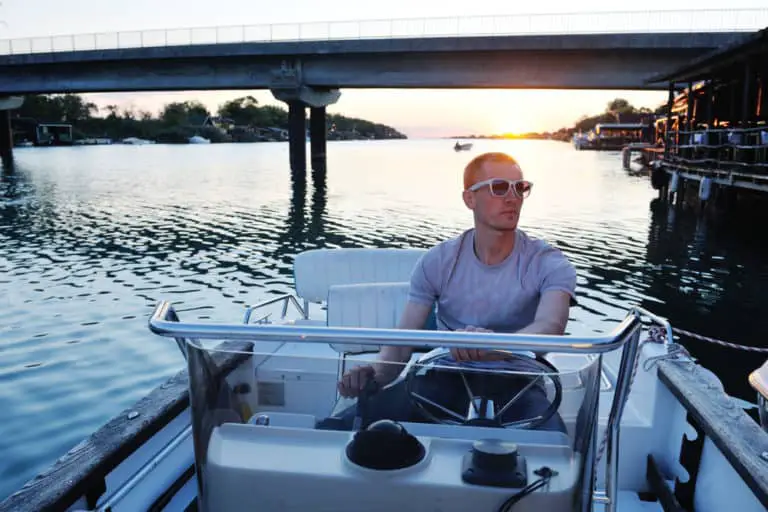
12 Practical Tips to Learn Boating Fast (2024)
For someone who wants to learn boating, it can be a bit intimidating looking from the outside in. You might…
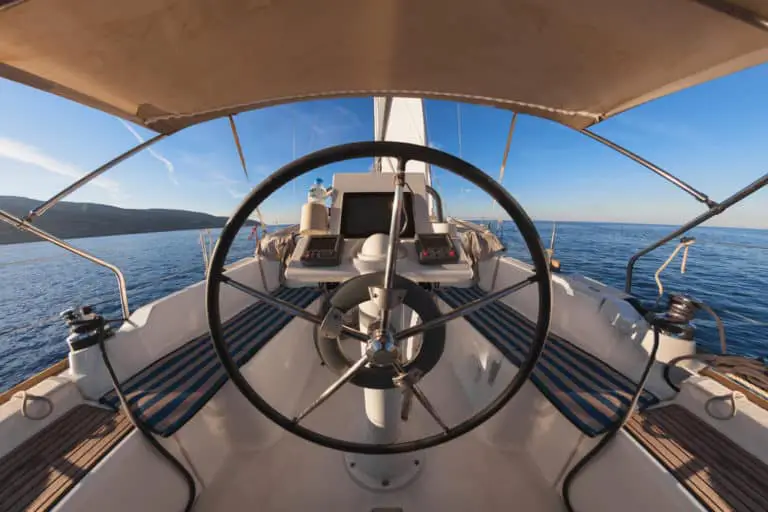
Boat Steering Systems: Everything You Need to Know (2024)
One of the most important tasks in your yearly boat maintenance routine will be the inspection and potential repair of…
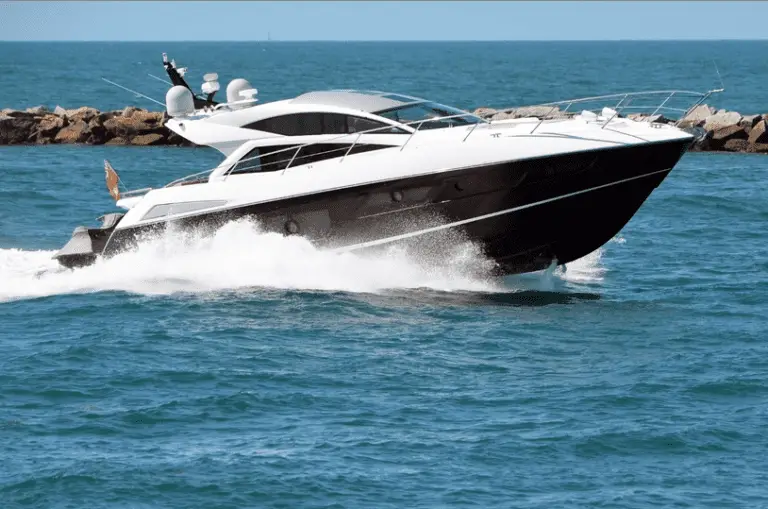
Cabin Cruiser: The Ultimate Guide (2024)
Passengers: Maximum 10Length: 20-40 FeetTrailerable: YesBest for: Day Cruising & Overnight TripsPrice Range: $100,000-$500,000Propulsion: 2+ Outboard Engines Many boaters want…
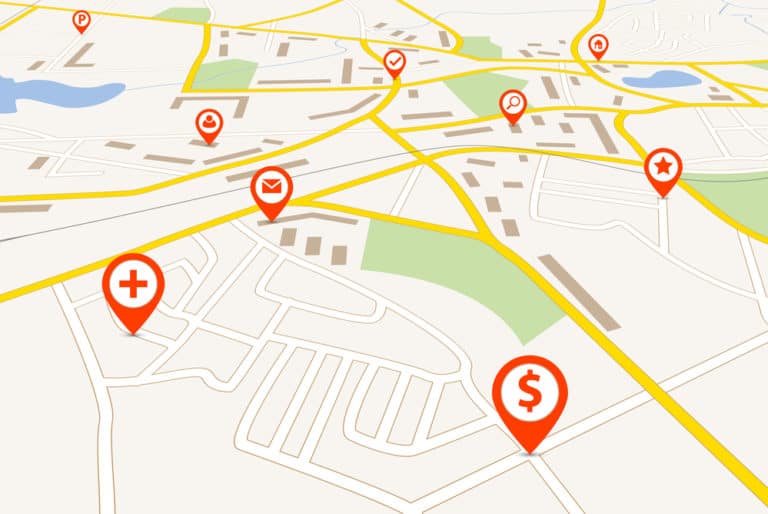
Glossary of GPS Terms in 2024 (The Definitive List)
Learning about global positioning systems or GPS can lead you down a rabbit hole of technical material, many dealing with…
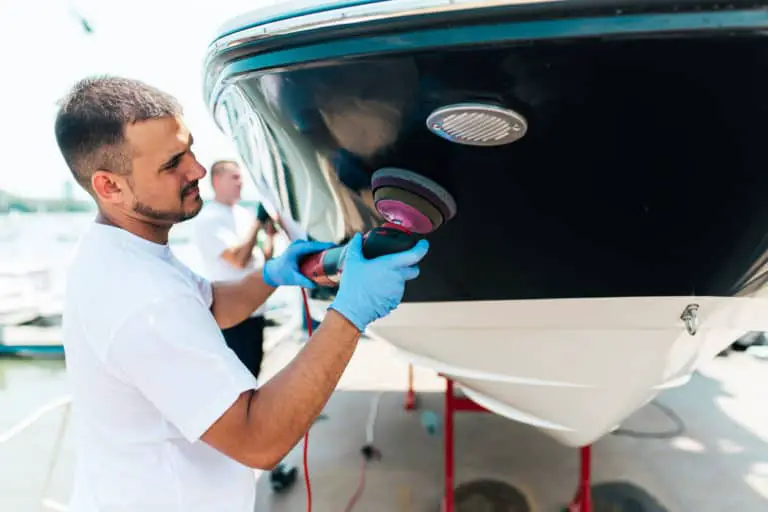
Boat Maintenance: The Definitive Guide (2024)
Many new boat owners are a little intimidated by the thought of the boat maintenance that they need to do….

Ultimate Guide To Marine Navigation Lighting
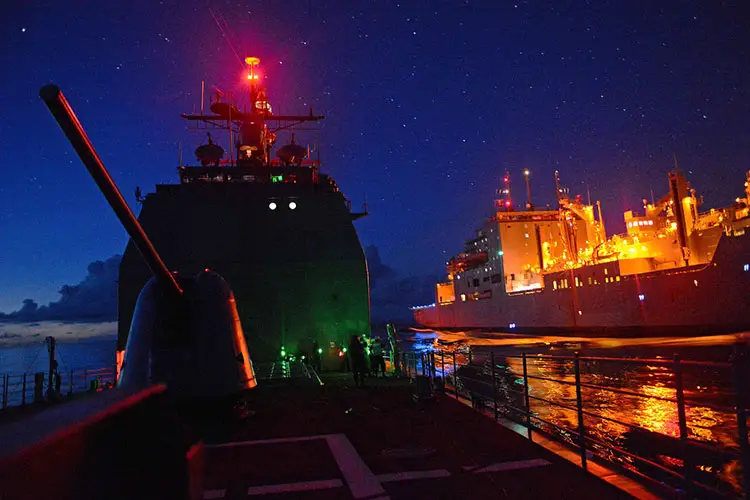
If you drive a car or even ride a bicycle, you might be well aware of the necessity of lighting systems (though in the second case the word ‘system’ doesn’t quite apply) for the safety of you and the people around you. The thing applies just as well for ships. But since they are much larger than a car, the lighting system or navigation lights on ships is a little bit more complicated as well. Marine navigation lighting is also one of the most critical aspects of nautical studies.
It is mandatory for boats of all sizes to have a navigation system . This is to make sure that the chances of any significant accident are minimized. The United States introduced the system in 1838, and the United Kingdom followed suit. Before being internationally adopted in 1897 suitable guidelines were established by the International Maritime Conference which was established in 1889. Three colors were chosen that were to be used for the light colors. They were red, green and white. This was based on a set of rules specified by the US and are followed around the world to this date.
This article discusses the different rules and regulations of using navigation lights, their importance, and also some basic marine navigation lighting systems along with their positions and ranges.
Marine Navigational Lights, Rules and Regulations
A standard pattern of marine navigation lighting is followed for the identification of both the vessel as well as the IALA buoyage system at night. If you are required to move from sea to a channel you need to have a list of all the IALA as well as the other fixed navigational lights that are visible on entering the channel. This includes distant lighthouses as well.
If you also make a note of the inland features like the radio and television transmitter masts it will benefit you because they act as good navigational aids due to their height and warning lights.
The helmsman should not be using any bright light source in the cockpit area and should rather take the aid of red lights and very dim white lights in the galley and navigation area. This is because he needs to preserve his night vision so that he can accurately interpret both the buoyage marine navigation lights as well as the boat navigation lights of other vessels.
The nautical almanacs contain the details of each and every visible maritime light signal coming from navigational markers that are both inside and outside the channel.
All the details about any particular light can be found in a published list or on a marine navigational lights chart: its color, period, and in some cases even the elevation and range of the beacon. Use the chart to keep a tag on the lights you are passing by putting a tick mark on the lights that you are about to pass and as the boat sails past, the tick is checked.
You will get two visual clues to figure out how far you are away from a buoy. The light will elevate from the horizon at 0.5 nm and at about 200m, the light will reflect on the surface.
Position of Boat Navigation Lights
Most of the variations that can be found in the different vessels can be read about in most almanacs. At the very basic level, a vessel needs to show a red light to port and green light to starboard. Depending on the size of the vessel, one or more colored or white lights are used as well.
For vessels that are 12 ft in length or shorter, the navigation lights must be visible from a range of one nautical mile and for the ones that are longer than 12 meters the required visibility range is 2 nautical miles. From 5 degrees above to 5 degrees below the horizontal happens to be the required minimum intensity in a vertical sector.
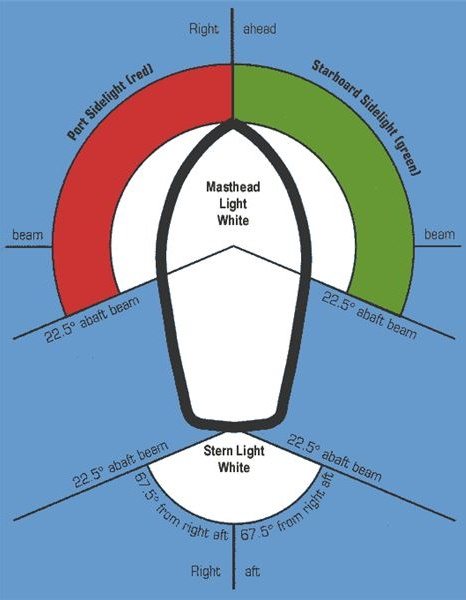
International Navigation Rules state that the boat navigation lights should be placed above the uppermost continuous deck. In case separate fixtures are used for the red and green sidelights, the masthead or all-round white light is placed as close as possible to the vessel’s fore and aft centerline. The masthead or all-around light needs to be positioned at least 1 m or 3.3 ft above the sidelights.
Following are the basic positions of navigational lights. We will discuss the same in greater detail ahead.
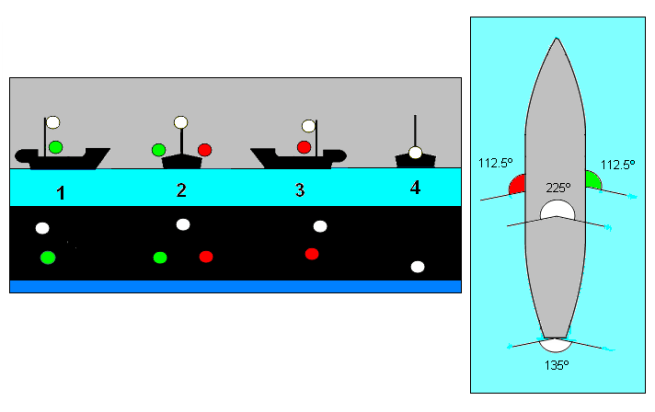
Also read: What Is A Marine Sextant?
Boat Navigation Light Regulations
Several rules and specifications are related to the type, size, layout, arc, and distance of visibility of boat navigation lights used by all vessel types which are collectively known as the International Regulations for Preventing Collisions at Sea or COLREGs . The navigational lights used are known as ‘COLREG lights and shapes. A boat might be anchored or underway, under sail or power, or fishing or trawling. These various situations can be communicated through multiple combinations of boat navigational lights.
In addition to the primary navigation lights, vessels may also display one or more steaming lights. These lights are very useful for it gives details about the various aspects of the ship like whether it is in the sail or under power, the direction in which it is going and, in some cases, even the size of the vessel. If a ship is engaged in a specific task that might involve certain restrictions, that too can be indicated with some extra boat lights.
Always maintain the lighting system and display the correct navigation light combination to make other vessels in the vicinity aware of your course and state as to whether your vessel is under power or not. If you follow this a considerable amount lowers the chances of a collision. Here is a list that you might use to familiarise yourself with the basics of the lighting system.
- Basic Navigation Light White Light : Small dinghies that are 7m or less in size are required to carry a torch having a white light that can be flashed when needed.
- All-Round White Light: An all-round white light is expected to be displayed by a small boat, up to 7ft long that is under power and can go beyond 7 knots of speed. This light must be visible at an angle of 360 degrees and from two miles away. An all-around white light is also used when the boat or vessel is at anchor but not at a designated anchoring area. This is to make sure that the ship is visible to all the nearby ships to avoid any accidents.
- Stern and Combined Side Lights : A stern light is a white light that is installed at the end of a boat. A vessel that is over 7 m or 23 ft in length is expected to show red and green sidelights when sailing. Each of these lights needs to cover an arc of 112.5°. The sidelights may be combined in one lantern at the bow when below 25 m or 65 ft. The white stern light can be seen over an arc of 135°. These lights need to be visible from a distance of a mile and need to be placed 39 inches below all white lights for boats of lengths equal to or less than 12 ft.
- Masthead Light : A combination of sidelight and stern light in a tricolor combination may be used sailing yachts of heights 20 m or lower. A masthead light is required by vessels of lengths between 39.4 ft and 65.6 ft. It is placed in the masthead whose height provides excellent visibility. Still, stern lights and sidelights should be fitted separately in case of or use under power along with steaming light. This kind of light needs to be visible across an angle of 225 degrees and from a minimum distance of 2 miles.
- Separate Lights : The displaying of the tricolor masthead light is not allowed in the case of yachts that are longer than 20 m or 65 ft. Instead, they use them separately. Often on large sailing vessels, these all-around, red over green lights are present. These red and green sidelights need to be visible from a distance of one mile and across an angle of 112.5 degrees.
- Steaming Lights Combined Lights : A combination of the masthead and stern light are used in the case of power crafts that are less than 20 m or 65 ft in length. The arrangement is present at the bow.
- Single Steaming Light : Visible over a 225 degrees arc, a masthead steaming light is used by power-driven vessels that are up to 50 m or 160 ft long. Separate stern lights and sidelights are used in case of a length exceeding 20 m or 65 ft.
- Two Steaming Lights: Power-driven vessels that span over 50 m or 160 ft in length display two masthead steaming lights. The forward light placed lower than the aft light with both of them being visible over an arc of 225° with the sidelights and separate stern light.
The area of the nautical lighting system is a precise business and requires some amount of study and a good deal of responsibility. It is because its application forms a core element in safe marine navigation.
Similar Posts
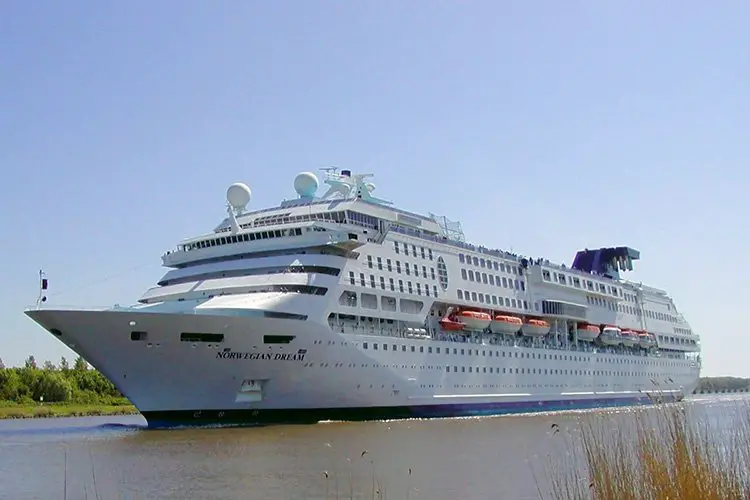
What Is The Hull Of A Ship?
The following article discusses the hull of a ship, what it is, how it is made, and what it means for the building of a ship. It also talks about how the hull of the ship is built by carrying out several mathematical calculations and taking into consideration, several other factors. What is the hull…
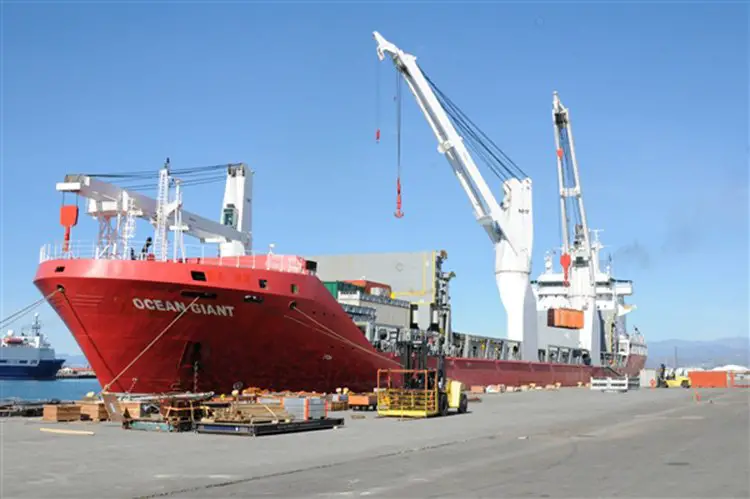
A Guide To Ship Prefixes For Naval And Merchant Vessels
What are Ship Prefixes? Ever wondered what does SS stands for on ships? Or what does USS stands for? Every single ship in the world has a name. It could be named after a country, a company, or even a famous personality. However, no matter the name of the ship, every ship much include certain…
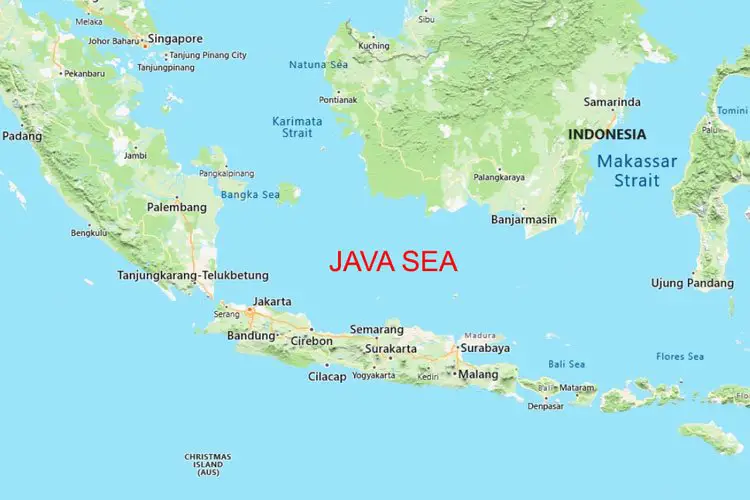
Interesting Facts About Java Sea
The Java Sea is located between the islands of Indonesia. It is a shallow and extensive sea on the Sunda shelf. Java sea has a long history and its geographical importance is well known because of the Battle of the Java Sea. Interesting Facts About Java Sea There are some fascinating facts about the Java…
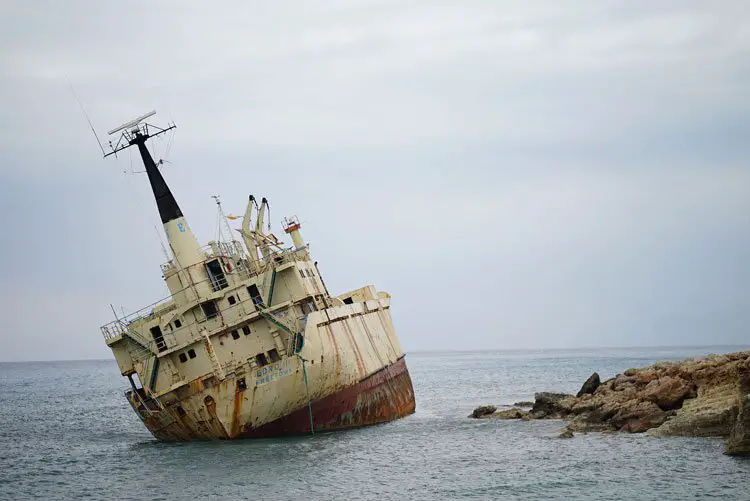
Capsizing and Reasons for Capsizing
What is Capsizing? Capsizing is a condition where the ship or the vessel turns to its one side or completely turns upside down in the water. Sometimes they can reverse to their original position, but most of the time ships either sink or have heavy damage. This is a dangerous situation for ship sailors, crew,…

St. Lawrence Seaway: A Vital Waterway For Canada & USA
St. Lawrence Seaway is a full-fledged waterway system that includes locks, channels, and canals that connects the Great Lakes to the Atlantic Ocean. Its length is 2,342-miles or 3,768-kilometer and is a major trade shipping route for both Canada and the USA. It came into use in 1959. There is a long history related to…
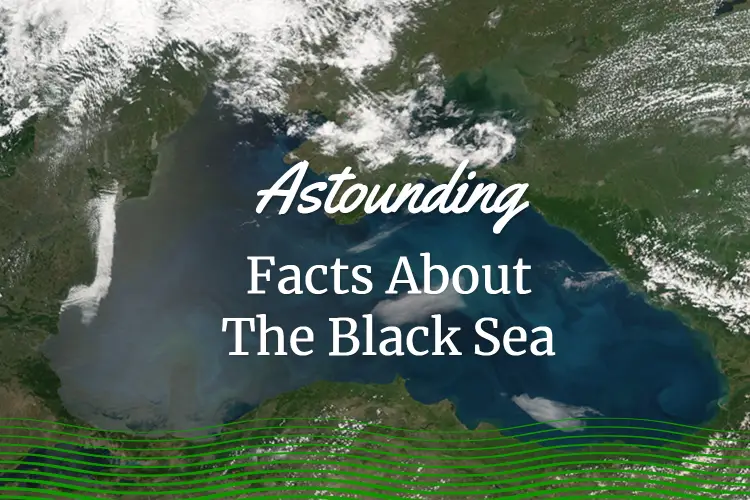
13 Astounding Facts About The Black Sea
The Black Sea is one of the most popular water bodies in the world. One of the most amazing things about it is that it’s an Inland Sea. Almost everyone who has studied in schools must have read about the Black sea in his or her geography textbook and the name kind of sticks to…
Leave a Reply Cancel reply
Your email address will not be published. Required fields are marked *
Save my name, email, and website in this browser for the next time I comment.
This website uses cookies to improve your experience. We'll assume you're ok with this, but you can opt-out if you wish. Read More

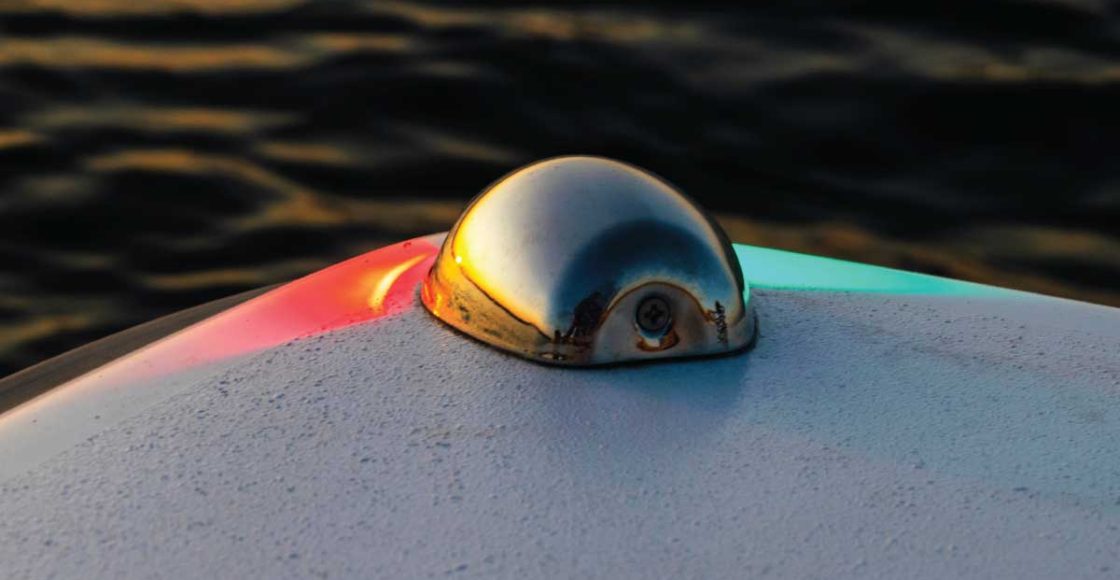
Boat Navigation Lights: Understanding the Basics

Table of Contents
Last Updated on July 19, 2022 by Boatsetter Team
For many boaters, the best way to end a beautiful day on the water is to watch the sun slowly drop below the horizon while it lights up the clouds and sky above. Others feel better heading to the dock before the sun goes down, while there is still plenty of light to illuminate the channel markers and other potential dangers.
Besides understanding boat navigation light rules, it is also important to understand:
- The overall purpose of boat navigation lights
- How to properly use boat navigation lights
- What the different colors (red and green) mean
Own a boat? Earn an avg. of $20K per season renting it out on Boatsetter
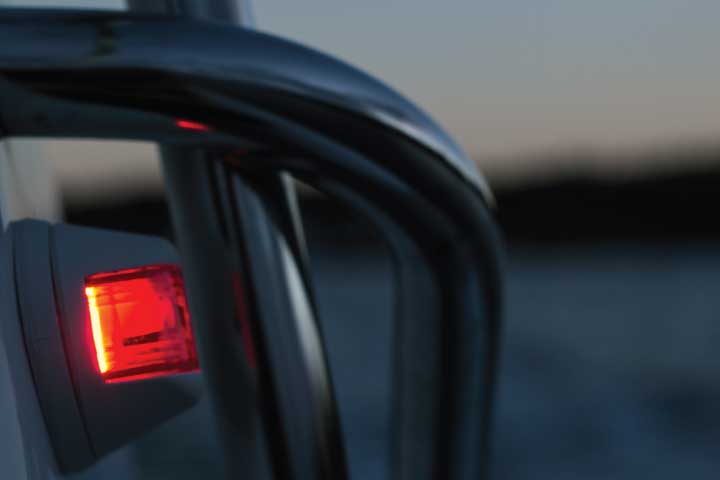
How do boat navigation lights work?
Boat navigation lights, or “nav lights,” are the colored marker lights visible on either side of the vessel and at the stern . These lights play essential roles in identifying the ship’s length, direction, and purpose!
The colored marker lights and where to find them go as follows:
- The boat’s port side is marked with a red light.
- The starboard side light is green.
- When looking at the boat’s transom or stern, a white light may be visible.
Keep in mind large boats and ships may use other colors, like yellow.
Next time you’re boating at night , say thanks to your navigation lights. They allow you to see other boaters in the dark and help prevent collisions. But there is much more to boat navigation lights than that.
How to use boat navigation lights
Each of the boat’s navigation lights is only visible for so many degrees of a circle to prevent confusion and accurately identify which side is in view.
By noting which colors are visible on another vessel, boaters can identify which direction the other boat is facing or headed. Knowing a boat’s direction can be especially important when crossing paths with another vessel in the dark.
If you walked around a boat at night while the navigation lights were on, the color visible would change depending on where you stood. When looking at the port side of the boat, the red light would be visible from dead ahead of the vessel to just past the center of the port side or through 112.5 degrees of a circle. Walk to the starboard side, and the green light would be visible from the bow to just past the boat’s center, or another 112.5 degrees.
Stand at the back of the boat, and you will see the white light visible for a total of 135 degrees from one side of the vessel to the other. Add up all three, and you’ll get 360 degrees.
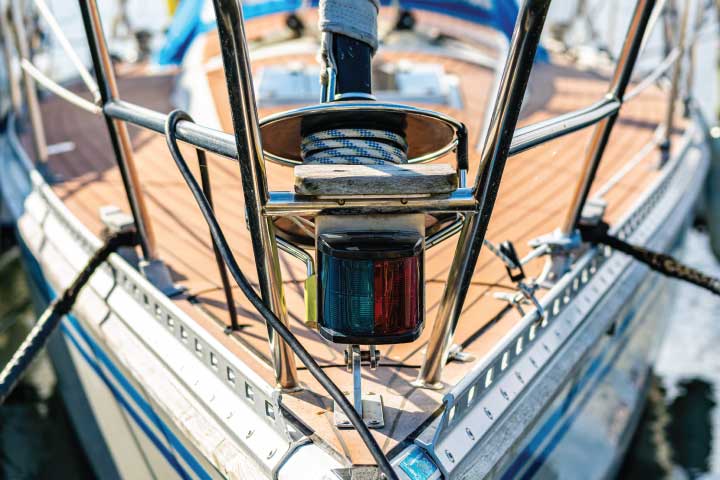
Boat navigation light color meanings
If you were on a boat at night and could see nothing but the different colored lights of another vessel ahead of you, you would still know exactly which way that boat was going.
- If you could only see the red light ahead of you, you would know that you are seeing the other vessel’s port side, or it is crossing in front of you from your right to left.
- The opposite is true if you saw the other vessel’s green light . You would be looking at the other vessel’s starboard side or watching the boat pass in front of you from left to right.
- If you see both red and green lights , then the other vessel is coming straight at you if you can see both red and green lights.
- If you can only see the white light and nothing else, you would look directly at the other boat’s stern as it drives away.
- Red and white means the boat is driving away from you, crossing from right to left.
- On the other hand, green and white signal that the vessel is moving away from you, crossing from left to right.
When renting a boat on Boatsetter , make it a habit of checking that navigation lights are working. You should turn on the navigation lights even if the sun is out. It’s the best and safest boating practice.
Want additional resources for boating?
Check out the links below for more information on boating.
- Navigation lights study guide
- Pre-departure boating checklist
- Boat Spring Commissioning Dewinterization Checklist
Don’t let your boat sit idly by. List it with us to earn $20K on avg.

Chuck Warren fell in love with boats at 9 years old while helping to restore his grandfather’s 1939 44-foot Elco cruiser. A lifelong boater, Chuck has experience operating large and small vessels on the waters of the Atlantic, Gulf of Mexico, Caribbean, and the Great Lakes.
During his 35-year marine industry career, Chuck has been the driver for several offshore powerboat racing teams, the chief engineer aboard a Caribbean research and salvage vessel, captain of a Florida Keys sunset cruise, and more.
Today, Chuck is a boating industry writer, copywriter, and captain who lives on his 40-foot boat in the summer when he isn’t delivering vessels around the Great Lakes or teaching new boaters to drive. Winters are split between the West Michigan lakeshore and wherever his travels take him.
Browse by experience

Explore articles

How to Clean a Boat
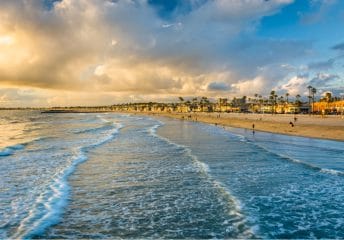
Best Newport Beach, CA Beaches
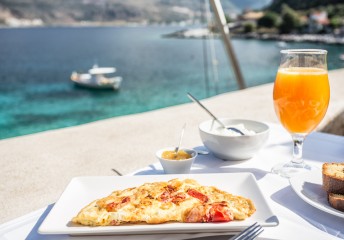
Brunch on a Boat: Here’s Our Advice

How to Bait a Hook with Shrimp
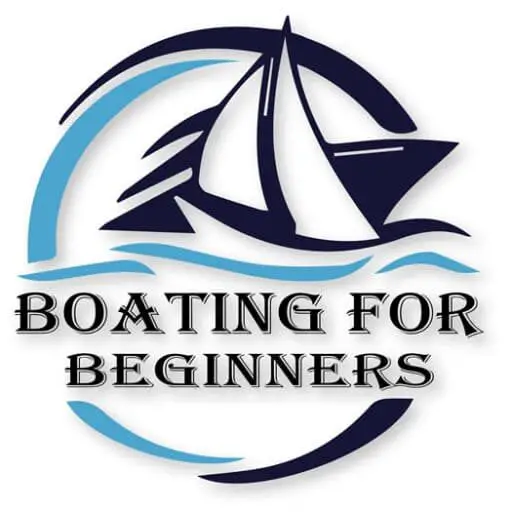
Boat Lighting – Complete Guide to Navigation Lights
I was sitting in the garage the other day admiring my boat when I noticed the green navigation light on the side of the hull, and it dawned on me that I haven’t had the boat out after sunset yet. It also got me wondering about the different places I’d like to travel this summer and what it would be like to navigate in the dark if I had to.
In addition to the legally required lights, I highly recommend having a marine waterproof spotlight in your boat at all times ( this is the one I prefer, which you can buy on Amazon with tons of good reviews ). The little headlight on a boat is nowhere near bright enough to safely navigate if you get caught on the water at night. Trust me, it can save you thousands in boat repairs and a dangerous situation.
I wanted to make sure that I fully understood everything there was to know about navigation lights, so I did some online research. I’ve put together a complete guide of the information I found online talking about the different navigation lights and what I needed to know about them.
What Are Navigation Lights On a Boat?
Boats require specific lighting configuration when operating between sunset and sunrise, or at times when visibility is restricted such as when it’s raining or foggy. Navigation lights are used to help other boaters see you when visibility is reduced, and it allows you also to see the other boaters to avoid collisions.
Navigation lights are also used to communicate with the other boats sharing the water. For example, the navigation lights can tell another boater, what size your vessel is, and in which direction you are heading. This information can be used by the boat caption to determine what the appropriate course of action would be as you approach each other.
By law, the navigation lights come in specific colors; white, red, and green. Even the arc of the illuminated light, the range of visibility, and the location is all specific to what type of vessel you are operating.
Do not assume that your boat came with the appropriate lighting or equipment from the factory or showroom. It is your responsibility to make sure that your boat has the proper navigation lighting configuration before you head out on the water.
What Type Of Boats Requires Navigation Lights?
Basically, in a nutshell, all boats require navigation lights if you’ll be operating them between sunset and sunrise, or whenever visibility is reduced.
This goes for the following types of vessels:
- Motorized vessels
- Non-motorized vessels
- Sailing vessels (Operating under sails)
- Sailing vessels (Operating under motor power)
- Vessels engaged in fishing
- Vessels engaged in trawling
- Towing vessels
- Anchored vessels
- Human-powered vessels such as Rowboats (Kayaks and canoes)
What Lights Are Required On a Boat?
Boats are required to have navigation lights. Navigation lights are required whenever you are operating your vessel between sunset and sunrise, or during any other times when your visibility is restricted from elements such as fog or rain.
The type of lights required depends on the length of your vessel as well as if it’s a powered or non-powered vessel. But in general, all navigation lighting systems will consist of red and green sidelights, as well as one or more white lights. A red sidelight indicates the port side of the vessel, while a green light shows the starboard side of the vessel. The white light in most cases is called an all-around light, which means it can be seen from any angle by other boaters.
Another type of navigation light is a yellow light. A yellow light is not very common to see, but if you do happen to see one, it would mean that a lead boat is towing another boat.
It is your responsibility to make sure you have the proper navigation lighting. It is also recommended that you take spare bulbs with you. The USCG doesn’t care if the lights were working when you left, they only care that the lights are not working when they are required.
Lights Required For Power Vessels Underway:
A powered vessel includes all motorized boats, including sailboats that use a motor.
Vessel length: Under 12 meters (39.4 FT.) Lighting requirement:
- One all-around white light that is visible at 360 degrees, and can be seen from two miles away. The all-around white light must be mounted at least 39 inches above the side lights.
- A pair of red and green sidelights that are visible 112.5 degrees and can be seen at least one mile away.
Vessel length: 12 meters to 20 meters (39.4 FT. to 65.6 FT.) Lighting requirement:
- A white masthead light located at the front of the boat, pointing in the direction you are traveling. This must be visible at 225 degrees and from two miles away. The masthead light must be positioned at least 8 feet above the gunnel.
- A white stern light located at the rear of the boat that is visible at 135 degrees and can be seen from 2 miles away.
Lights Required For Non-powered Vessels Underway:
A non-powered vessel includes sailing vessels and all other types of vessels that don’t have motors such as paddled, poled, or rowed.
Vessel length: Under 7 meters (23 FT.) Lighting requirement:
- You are required to display a white light that can be seen by other boats. White light could consist of a flashlight, torchlight, or lantern.
- If you can, it is recommended that you have an onboard 360-degree white light all-around set on the horizon, with a distance of at least two miles.
Vessel length: Over 7 meters (23 FT.) – NEED 3 IMAGES Lighting requirement:
- A pair of red and green sidelights, that are visible 112.5 degrees and can be seen at least one mile away.
- Alternatively, for sailboats of that are over 7 meters in length, they can display what is called a tricolor light A tricolor light can only be used while the vessel is underway using sails alone and never while underway by power. This light should also never be used at the same time that the regular sidelights are on. Either the tricolor light or sidelights can be displayed, but never both.
Lights Required For Vessels At Anchor (Less Than 50 Meters):
This rule applies if you are anchored away from a designated area such as a marina.
Vessel length: 12 meters to 20 meters (39.4 FT. to 65.6 FT.) Lighting requirement:
- White all-around light is required to be used so you are visible to other ships that could be in the area.
Due to variances in state boating laws/regulations, NASBLA does not provide state-specific information. You may contact your state boating office for the most accurate information. Contact information can be found here: https://www.nasbla.org/about-nasbla/boating-contacts .
Understanding The Difference Between Port And Starboard Lights
While standing on the deck and facing the front of the ship, the left side is called the Port and the right side is called the Starboard. The port is always red , while the starboard is always green .
This information is crucial to understand if you ever find yourself trying to navigate the waters at night or while your visibility is limited. For example, if you are sailing towards another vessel, you will be able to tell if that vessel is heading towards you, or if it is heading away from you based on which side the green and red lights appear to you.
If you see a red light coming towards you, that would mean the other boat is on your right, which means that boat would have the right of way. If you see a green light from an oncoming vessel than you would know that it’s on your left, which means you have the right of way.
When Should Navigation Lights Be Displayed On a Boat?
Navigation lights are required to be displayed in between sunset and sunrise, and anytime that visibility is restricted. For example, due to fog or rain.
Where Can You Buy Navigation Lights?
As discussed earlier, not all boats automatically come with the proper display of navigation lights. It is your responsibility to ensure that your boat has all of the proper equipment for your safety and the safety of others.
The prices for navigation lights will vary anywhere between $9.00 to $100.00 depending on what style and manufacturer you buy. You could even spend as much as $500.00 on some of the higher-end navigation lightings. Be sure to shop around and take a look at what is available, to ensure that you are finding the best lights, at the best prices.
Definitions
All-Round Light: White (32pt/ 360°) Masthead Light: White (20pt/ 225°) Sidelights: Red (10pt/ 112.5°) & Green (10pt/ 112.5°) Stern Light: White (12pt/ 135°)
Similar Posts
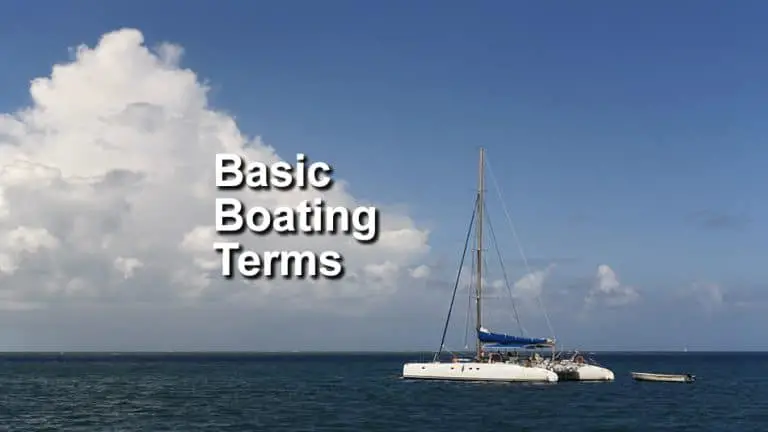
Basic Boating Terms That Beginners Should Learn
It’s always fun and exciting to go on a boating trip, but this does come with its fair share of challenges. The idea is to know precisely how to control your boat and get it to the desired fishing location. That’s why it makes a lot of sense to learn as many boating terms as…

Helpful Tips For Towing a Boat
Every boat owner knows that being able to take your boat everywhere you want is a privilege and a great way to spend your time. However, there are specific rules you have to abide when you want to tow a boat. Some states require special trailer brakes especially if the boat has more than the…
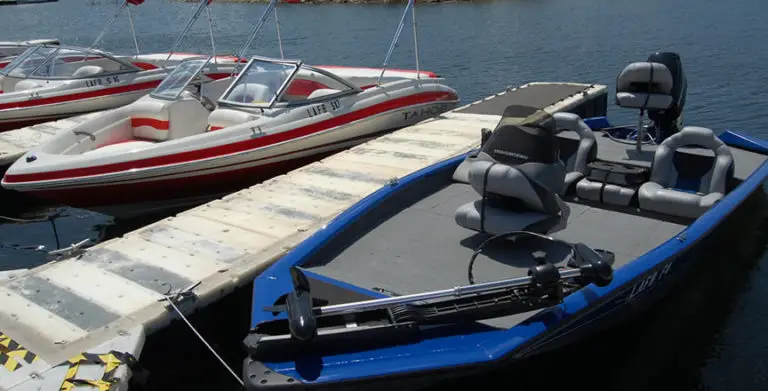
Best Boats For Beginners
This post is a beginners guide to buying your first boat. When I first started to dig deep into the research and figure out what the best types of boats for beginners were, I had no idea that there were so many different types of boats to choose from. There are so many different choices…

Starting Boat Motor Out Of Water
I’ve heard a lot of boaters talking about how they start their inboard or outboard engine while the boat is on land so they can test the motor before they have it on the boat launch. That got me wondering how safe it could be for the engine, so I did some research. As it…
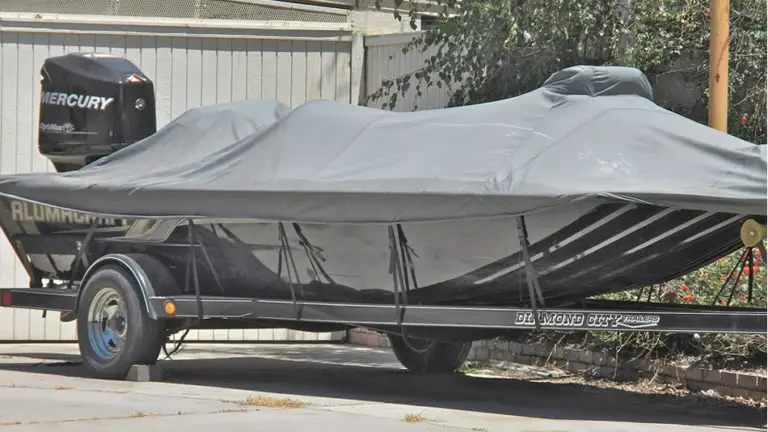
Boat Security – How to Prevent Your Boat From Being Stolen
I’m sitting here on a dock enjoying the sun and watching the boats cruise around. Not far from me is a marina filled with a lot of really lovely expensive ships, and it got me asking myself “what kind of boat security would these people have to prevent their boat from being stolen?”. Then it…
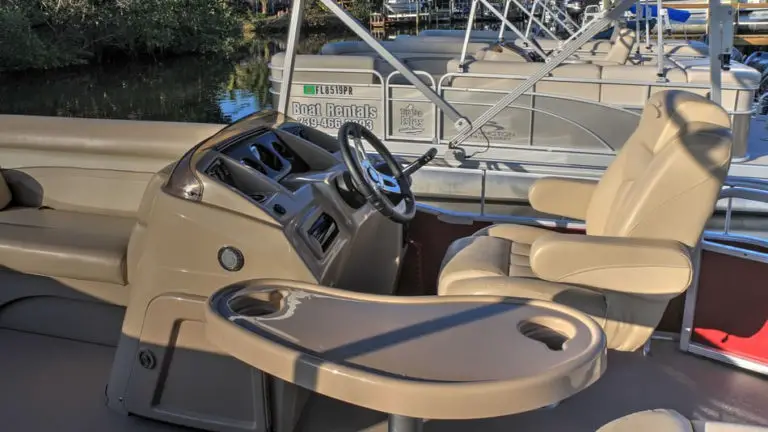
Which Boat Seat is Right For You
When it comes to boat seats there’s more to them then you think. There are many different styles and levels of comfort to choose from, similar to how there are many different styles of couches or recliners you can buy for your living room at home. Picking the right seat for you depends on you…


LOCATED ON THE EDGE OF BEAUTIFUL LAKE COEUR D'ALENE
Marine Navigation Lights: The Complete Guide

Navigating the open waters can be a thrilling experience, but it is also a responsibility that requires preparation and knowledge. A crucial aspect of safe boating is the use of navigation lights, which are lights placed on boats to help other boats and vessels identify the boat’s position, heading, and intent. In this article, we will provide a complete guide to marine navigation lights, including the different types, requirements, and regulations.
Every State Has Different Boating Laws & Regulations
While some of these laws are universal across the states, many of them vary by location. Before heading out onto the water, make sure that you do research for your specific area and understand what is permissible in regard to safety guidelines or even local limits on fishing. Knowing the local regulations can not only make your trip go more smoothly but can also help keep you and your fellow water-goers safe.
Types of Navigation Lights
Masthead Light : This is a white light with a 225-degree arc, placed at the highest point of the boat. This serves as the primary light for other boats to identify your vessel’s position. The masthead light is a white light that must be visible for at least 2 miles.
Stern Ligh t: This white light is placed at the stern (rear) of the boat with an arc of 135 degrees and serves to indicate the boat’s direction of travel. The stern light is a white light that must be visible for at least 2 miles.
Starboard Lights : A green light, with an arc of 112.5 degrees should be displayed on the starboard side of your boat.
Anchor Light : The anchor light is a white light that is used when a boat is anchored. This light must be visible from a distance of 2 miles.
Port Side Light : A red light, with an arc of 112.5 degrees should be displayed on the port side of your vessel any time there is minimal light or visibility.
Towing Light : This light is used by boats that are towing another vessel. The towing light is a yellow light that must be visible from a distance of 2 miles.
What is the arc of visibility in lights?
This degree measures how far a light’s ray can be seen from the side or from behind during dark hours. They are usually required 30 minutes prior to the sunsetting.
Regulations and Requirements
The International Regulations for Preventing Collisions at Sea (COLREGs) dictate the use and specifications of navigation lights for boats. The COLREGs specify that boats must display the proper lights during hours of darkness and in conditions of reduced visibility, such as fog. Boats must also have a backup lighting system in case the primary system fails.
It is important to note that different types of boats have different requirements for navigation lights. For example, a sailboat under sail must display different lights than a powerboat. It is the responsibility of the boat owner to ensure that their vessel is equipped with the proper lights and that they are in compliance with the regulations.
Maintenance and Replacement
Regular maintenance of navigation lights is essential to ensure that they are in proper working order. This includes checking the batteries, bulbs, and wiring, as well as ensuring that the lights are securely mounted and not obstructed.
It is recommended that navigation lights be replaced every two years or as needed. When replacing lights, it is important to use lights that meet the COLREGs specifications and are approved for use on boats.
Additional Boat Safety Information
In addition to the navigation lights, there are other safety measures that boat owners should take to ensure a safe boating experience.
These measures include having properly working equipment, such as life jackets, fire extinguishers, and communication devices, as well as being prepared for emergencies.
It is important for boat owners to understand the rules of the water and to always follow them. For example, boat operators should be aware of the right-of-way rules, which dictate which vessel has the responsibility to avoid a collision. Boat owners should familiarize themselves with the signs and markers used on the water, such as buoys and channel markers, which indicate the location of navigational hazards and indicate the recommended course for boats to follow.
Boat owners should also be prepared for sudden changes in weather and water conditions. This includes having appropriate clothing and gear for the conditions, as well as monitoring the weather and water conditions and being prepared to take action if conditions change.
Lastly, it is important for boat owners to educate themselves and their passengers about boating safety. This includes taking a boating safety course, which can provide information about the rules of the water, the use of navigation lights and equipment, and emergency procedures.
Enjoy Boating Safely
Marine navigation lights play a critical role in safe boating by helping other boats and vessels identify a boat’s position, heading, and intent. It is important for boat owners to be knowledgeable about the different types of navigation lights, the regulations and requirements, and the importance of regular maintenance. By following these guidelines, boat owners can ensure a safe and enjoyable experience on the open waters.
Sailboat Navigation Lights: A Guide to Safe Nighttime Sailing
by Emma Sullivan | Jul 26, 2023 | Sailboat Maintenance

==Short answer sailboat navigation lights:== Sailboat navigation lights are essential safety features that help vessels communicate and avoid collisions at night. These lights, such as the red and green sidelights and white stern light, allow sailors to determine the direction and status of approaching boats.
Understanding the Importance of Sailboat Navigation Lights
Sailing, with its air of romance and adventure, is a timeless pursuit that has captured the hearts of seafarers for centuries. While sailing enthusiasts revel in the sense of freedom and connection with nature that this activity provides, it is crucial to recognize that safety should always be a top priority when out on the open water. Among the many precautions taken to ensure safe navigation, sailboat navigation lights play an essential role.
These lights serve as beacons in the darkness, guiding both sailors and other vessels on their watery voyages. They are particularly vital during low visibility conditions such as fog, twilight, or nightfall when discerning a sailboat’s presence can be challenging. By understanding the importance of sailboat navigation lights, sailors can take proactive steps towards avoiding collisions and mishaps while enjoying their time at sea.
First and foremost, these lights serve as a communication tool between vessels. Just as traffic signals guide drivers on roads, sailboat navigation lights communicate a vessel’s navigational status to others nearby. These lights convey critical information about a boat’s direction of travel and whether it is under power or relying solely on wind propulsion. This enables other boats to predict potential collision courses and adjust their own paths accordingly.
In terms of regulatory compliance, having properly functioning navigation lights is not just recommended; it is required by international maritime laws like The International Regulations for Preventing Collisions at Sea (COLREGS). These regulations provide clear guidelines for different types of watercraft around the world to standardize safety measures. Following these rules ensures that every sailor speaks the same language when at sea, diminishing misunderstandings and encouraging mutual respect among mariners.
Furthermore, sailboat navigation lights contribute significantly to situational awareness – an invaluable asset in any seafaring endeavor. By displaying specific colors and configurations such as red/green sidelights and a white stern light visible from 135 degrees, sailors can discern the orientation of approaching vessels even in complete darkness. This knowledge empowers sailors to make informed decisions about altering their course or speed to avoid potential dangers.
In addition to enhancing navigation safety, sailboat navigation lights also add a touch of elegance and charm to nighttime voyages. Picture yourself sailing under a summer moonlit sky, with the soft glow of your vessel’s navigation lights casting mesmerizing reflections on the water’s surface. These lights not only provide reassurance but also create an enchanting ambiance for both sailors and onlookers.
While it may be tempting to dismiss the importance of sailboat navigation lights as just another cumbersome boat regulation, understanding their indispensable role is crucial for every sailor’s peace of mind and for ensuring uninterrupted enjoyment of our beloved pastime. So next time you set sail, remember that these little beacons serve as more than mere accessories – they are your allies in darkness, silently guiding you towards safe passages and unforgettable adventures on the open sea.
How to Properly Install and Operate Sailboat Navigation Lights
When it comes to sailing, safety should always be a top priority. And one of the essential safety measures on a sailboat is proper navigation lighting. Sailboat navigation lights help other vessels identify your boat’s position and course, especially during low visibility conditions or at night. In this blog post, we will guide you through the correct installation and operation of sailboat navigation lights to make your sailing adventures safe and enjoyable.
Installing sailboat navigation lights may seem like a simple task, but there are several key factors to consider for optimal functionality. First and foremost, familiarize yourself with international regulations regarding navigation lights. These regulations ensure consistency across different countries and improve communication between vessels on the water.
Before starting the installation process, carefully choose high-quality LED lights specifically designed for sailboats. LEDs offer numerous advantages over traditional incandescent bulbs, including energy efficiency, higher light output, longer lifespan, and reduced heat emission. Additionally, LEDs are more durable and resistant to vibrations commonly experienced while sailing.
To begin installing your sailboat navigation lights:
1. Determine the appropriate locations: Positioning your navigation lights correctly is crucial to maximize their visibility and effectiveness. Refer to your boat’s owner’s manual or consult with a marine electrician to identify the ideal mounting points for each light.
2. Prepare wiring routes: Plan out the wiring routes before drilling any holes or mounting fixtures. Concealing wires within the boat’s structure not only enhances aesthetics but also minimizes potential damage caused by exposure to external elements.
3. Drill strategically: Using an appropriately sized drill bit, carefully create mounting holes following the instructions provided by the manufacturer of your chosen navigation lights.
4. Connect electrical components: Install a waterproof junction box near each light fixture to protect wires from moisture and corrosion. Make connections following color-coded standards (red wire – positive; black wire – negative), ensuring proper polarity is maintained throughout the circuit.
5. Securely attach fixtures: Once all wiring connections are made, attach the navigation light fixtures to their designated mounting positions. Double-check that they are secure and properly aligned to maintain optimal visibility.
With your sailboat navigation lights installed, it’s time to understand their operation. Different situations call for specific combinations of lighting:
1. Underway with power: When sailing under engine power, display both a red (port side) and a green (starboard side) light visible from dead ahead to 22.5 degrees abaft each beam. A white stern light should also be shown.
2. Sailing without power: When solely relying on wind propulsion, display just the red and green sidelights in the same manner as during powered navigation.
3. At anchor: If you’re moored or anchored, only exhibit an all-around white light at a location high enough to illuminate unobstructed from every angle.
4. Restricted maneuverability: In situations where your sailboat’s maneuverability is impaired (e.g., towing another vessel), use three shapes—two balls vertically aligned above one diamond—to indicate restricted movement.
Lastly, always ensure proper maintenance of your sailboat navigation lights:
1. Regularly inspect for damage: Routinely check for signs of wear and tear on the electrical connections, housing seals, lenses, and reflectors. Replace any damaged components promptly.
2. Clean for maximum visibility: Keep lenses clean from dirt, grime, salt residue, or any other obstructions that could limit the effectiveness of your navigation lights.
3. Carry spare bulbs/batteries: Be prepared by carrying backup LED bulbs or batteries in case of failure during extended voyages.
By following these installation steps, understanding proper operation techniques according to maritime regulations, and maintaining your navigation lights diligently; you can cruise confidently knowing your sailboat is equipped with highly visible and functional navigation lighting system—an important feature enhancing safety while enjoying the open water at any time of day or night. So, set sail with peace of mind and navigate the seas safely while embracing the thrilling adventures that await you!

Step-by-Step Guide: Setting Up Sailboat Navigation Lights for Safe Sailing
Welcome aboard, fellow sailors! Today, we are going to dive into the nitty-gritty of setting up sailboat navigation lights for safe sailing. As you know, proper navigation lights are an essential part of ensuring your safety on the water, especially during low-light conditions and at night. So grab your cup of coffee, sit back, and prepare to learn how to illuminate the seas like a professional.
Step 1: Know Your Lights Before we jump into the technicalities, let’s familiarize ourselves with the different navigation lights required on a sailboat. These include the red port light on the left side, green starboard light on the right side, white stern light at the rear, and if our boat is longer than 20 meters (or 65 feet), a white masthead light at its highest point. Having this knowledge sets you up for success in navigating effectively while abiding by maritime regulations.
Step 2: Choose Your Lighting System Now that we’ve covered the basics, it’s time to decide which lighting system is most appropriate for your sailboat. You have two options: traditional incandescent bulbs or modern LED lights. While both serve their purpose well, LED lights are more energy-efficient and tend to last longer – a win-win situation!
Step 3: Gathering Materials To ensure smooth sailing throughout this process (pun intended), gather all necessary materials beforehand. This includes navigation lights (either incandescent bulbs or LED lights depending on your preference), wiring connectors, heat shrink tubing (to protect connections from moisture), electrical tape, wires (preferably color-coded for easy identification), wire strippers/cutters, and mounting hardware suitable for your boat.
Step 4: Planning Placement Consideration of placement plays a crucial role in setting up navigation lights effectively. Ensure visibility from all angles without obstructing other boat equipment or compromising aesthetics onboard. Take note of any manufacturer guidelines provided with your purchased lights for optimal placement. Remember, safety doesn’t mean sacrificing style!
Step 5: Wiring Your Lights Now we’re getting hands-on! Let’s start with the stern light. Attach the wires of your chosen light to the existing electrical system using appropriate connectors and ensure a secure connection. Utilize heat shrink tubing and electrical tape to safeguard against any moisture-induced malfunctions. Repeat this process for both port and starboard lights.
Step 6: Don’t Forget the Masthead Light If your sailboat exceeds 20 meters in length, you’ll need a masthead light too. Carefully mount this light on top of your mast using suitable hardware. Then, run additional wires through the mast to connect it securely with your electrical system.
Step 7: The Proof is in Testing After successfully wiring all navigation lights, it’s time for a crucial step – testing! Double-check that all connections are secure and operational before venturing out onto the open water. Be meticulous; don’t let a faulty bulb ruin your sunset cruise or impede your journey under a moonlit sky.
Congrats, sailors! You’ve now mastered the art of setting up sailboat navigation lights for safe sailing. Remember, maintaining these lights should be an essential part of regular boat maintenance as well. With proper illumination, maritime rules adhered to diligently, and cautious seamanship skills mastered, you can enjoy many breathtaking nights on tranquil waters without compromising safety. So go forth into the starry night with confidence and raise anchor towards new horizons! Bon voyage!
Frequently Asked Questions About Sailboat Navigation Lights, Answered!
Title: Frequently Asked Questions About Sailboat Navigation Lights, Answered!
Introduction: Navigating a sailboat safely and responsibly requires understanding and adhering to various rules and regulations. One vital aspect of sailing is ensuring proper use of navigation lights. These lights not only aid in visibility but also help communicate with other vessels on the water. In this blog post, we will delve into frequently asked questions about sailboat navigation lights, offering detailed professional answers infused with wit and clever insights.
1. Why are navigation lights necessary for sailboats? Navigation lights serve as visual signals that enable sailors to identify vessel types, positions, and movements at night or in low visibility conditions. They are crucial for promoting safety on the water by helping prevent collisions and aiding in the communication between boats.
2. What are the different types of navigation lights found on a sailboat? Sailboats typically feature three main navigation lights: red (portside), green (starboard side), and white (stern light). The red light tells other sailors that your boat’s portside is facing them, while the green light indicates that your starboard side is visible. The white stern light illuminates the rear of your vessel, making it easier for others to determine your direction of travel.
3. When should I turn on my sailboat’s navigation lights? According to international rules of collision avoidance at sea, all vessels must show proper navigation lighting between sunset and sunrise or during periods of restricted visibility such as fog or heavy rain showers. It’s essential to remember that even during daylight hours if visibility drops due to poor weather conditions, switching on navigational lights can greatly enhance safety.
4. Are there any additional requirements regarding sailboat navigation lighting? Yes! Aside from displaying the three main distinct navigation lights mentioned above, it is crucial for sailboats under power or motorsailing – using engine power alongside sails – to display an additional white forward-facing masthead light apart from the stern light. This masthead light helps identify the sailboat as a power-driven vessel, providing further clarity to nearby boaters.
5. Can I use LED lights for navigation purposes on my sailboat? Absolutely! In fact, LED lights are highly recommended for their energy efficiency and prolonged lifespan compared to traditional incandescent bulbs. However, it is essential to ensure that any LED navigation lights you use adhere to relevant maritime regulations concerning color, visibility range, and intensity.
6. How can I check if my sailboat’s navigation lights are working correctly? Regular maintenance and testing of your navigation lights are vital to guarantee their functionality when needed the most. Before every outing, visually inspect each light for signs of damage or corrosion. Additionally, switch on all navigational lights while docked or at anchor to verify they illuminate brightly according to the appropriate standards laid out in navigational lighting regulations.
Conclusion: Understanding sailboat navigation lighting not only ensures your safety but also promotes effective communication with other vessels on the water. By knowing when and how to properly utilize these lights, you contribute to maintaining a harmonious sailing environment. Remember, navigating with wit means being informed and cleverly enhancing your skills as a sailor while keeping safety at the forefront of your adventures!
Top Tips and Best Practices for Maintaining Sailboat Navigation Lights
Maintaining Sailboat Navigation Lights: Expert Tips and Best Practices
Picture this – you’re out on the open water, gliding along with the wind in your sails. As the sun dips below the horizon, darkness begins to envelop your sailboat. This is when maintaining proper navigation lights becomes paramount for both safety and legal compliance. In this blog post, we will dive deep into top tips and best practices for ensuring that your sailboat’s navigation lights are not only functioning but also showcasing their brilliance.
1. Regular Inspections are Key: To ensure your sailboat navigation lights are in prime condition, regular inspections should be conducted. Make it a habit before every trip to thoroughly examine all lights, from bow to stern. Look out for any loose connections, cracked lenses, or water intrusion that could hamper their effectiveness.
2. Ensure Proper Power Supply: One common issue faced by sailors is inadequate power supply to navigation lights, leading to dimness or complete failure at crucial times. Check that the wiring system is correctly connected and working optimally. Additionally, consider installing a voltage monitor or battery analyzer to keep tabs on power levels during extended journeys.
3. Choose LED Lights: When it comes to choosing sailboat navigation lights, opt for LED technology without hesitation. LEDs offer brilliant luminosity while consuming minimal power compared to traditional incandescent bulbs. Their longevity and durability make them ideal for equipping your vessel’s masthead light, sidelights, stern light, and anchor light.
4. Cleaning is Essential: Navigation lights on a sailboat accumulate dirt and grime over time due to exposure to various elements like saltwater spray or bird droppings (we all know how seagulls love making our boats their restroom). Regularly clean the lenses with a soft cloth and mild soap solution followed by drying with a lint-free towel. Keeping them crystal clear will maximize their output and visibility range.
5. Protect Against Moisture: Water ingress can be a persistent menace, harming the functionality of your sailboat’s navigation lights. To combat this, ensure watertight seals around light fixtures and wiring connections. Applying silicone lubricant or dielectric grease to connectors further enhances protection against moisture.
6. Carry Spare Bulbs and Fuses: Murphy’s Law states that anything that can go wrong, will go wrong – especially in the middle of nowhere. Imagine how disheartening it would be if one of your navigation lights suddenly fizzles out on a moonless night! Always carry spare bulbs and fuses suited for your specific lighting system to avoid such predicaments and keep your journey uninterrupted.
7. Stay Familiar with Navigation Regulations: Being updated on marine regulations regarding navigation lights is not only essential for your safety but also ensures compliance with local laws. These regulations dictate the placement, colors, and timings for displaying navigational lights based on different conditions such as underway, anchored, or sailing near other vessels at night.
In conclusion, maintaining sailboat navigation lights might seem like a mundane task; however, its significance cannot be undermined when it comes to safety during nighttime voyages. Regular inspections, adequate power supply, LED technology adoption, cleanliness, moisture protection, carrying spare bulbs/fuses, and adhering to maritime regulations should become second nature for any seasoned sailor. By following these top tips and best practices meticulously, you’ll be able to navigate the vast expanse of dark waters with confidence while ensuring a safe voyage each time.
Exploring Different Types and Designs of Sailboat Navigation Lights
When it comes to sailing at night, having the right navigation lights on your sailboat is absolutely crucial. Not only do they help you stay safe and avoid collisions with other vessels, but they also ensure that you are compliant with maritime regulations. In this blog post, we will be exploring different types and designs of sailboat navigation lights, so you can make an informed decision for your own vessel.
One of the most common types of sailboat navigation lights is the sidelight. These lights are usually mounted on either side of the boat and emit a green light on the starboard (right) side and a red light on the port (left) side. The purpose of these lights is to signal the direction in which your boat is moving to other vessels in the vicinity. Additionally, sidelights should be visible at a distance of at least two nautical miles, ensuring that other boats have ample time to react accordingly.
Another important type of navigation light for sailboats is the sternlight. As its name suggests, this light is mounted at the back or stern of the boat and emits a white light. The sternlight helps other vessels determine if you are moving away from them or approaching them from behind. It should be visible from a distance of at least two nautical miles as well.
In addition to sidelights and sternlights, sailboats also require an all-round white light, commonly known as an anchor light. This light serves as both an anchoring indicator and a warning signal to other boats that your vessel isn’t under power and may be stationary. Typically mounted atop the mast or another elevated point on the sailboat, this white light must be visible from all directions within two nautical miles.
Now that we’ve covered the main types of sailboat navigation lights, let’s delve into their designs. While traditional incandescent bulbs were once widely used for their simplicity and affordability, LED technology has revolutionized marine lighting. LED navigation lights are highly energy-efficient and have a considerably longer lifespan compared to incandescent bulbs. Additionally, LEDs emit a bright and focused light, making your sailboat more visible to others even in adverse weather conditions.
Furthermore, many LED navigation lights come with built-in features that enhance safety and convenience. Some models have automatic sensors that adjust the brightness of the lights depending on the ambient lighting conditions. This means that if you’re sailing during twilight or dawn, when visibility is reduced, these lights will automatically become brighter for better detection by other vessels.
Moreover, some innovative designs include combination lights that incorporate both sidelights and sternlights in one compact unit. These multifunctional lights save space on your boat while still ensuring compliance with regulations. Additionally, there are folding or telescopic navigation lights available that can be easily stowed away when not in use, further optimizing your deck space.
In conclusion, choosing the right types and designs of sailboat navigation lights is crucial for safe night sailing and regulatory compliance. Sidelights, sternlights, and anchor lights are essential components of any sailboat’s lighting system. Consider opting for energy-efficient LED technology that offers enhanced visibility and longevity compared to traditional incandescent bulbs. Moreover, explore innovative designs such as combination lights or folding options to optimize space onboard your vessel. By equipping your sailboat with the right navigation lights, you can navigate confidently through the darkness while captivating other sailors with your illuminated elegance on the open sea!
Recent Posts

- Sailboat Gear and Equipment
- Sailboat Lifestyle
- Sailboat Maintenance
- Sailboat Racing
- Sailboat Tips and Tricks
- Sailboat Types
- Sailing Adventures
- Sailing Destinations
- Sailing Safety
- Sailing Techniques
Marine Navigation Lights: A Boater’s Guide
As a seasoned boater or a seafaring enthusiast, your understanding of marine navigation lights can make a vast difference in your nocturnal and low-visibility voyages. Precision in navigating the open waters lies not only in skill but also in the silent language of luminescence, communicated through the boat navigation lights . Whether adrift at twilight or in the embrace of a foggy morning, these lights play a pivotal role in your safety and compliance on the water.
Navigating the waterways, you’re mandated to display red and green sidelights that reveal your port and starboard orientations, accompanied by distinctive white lights that cut through the darkness or fog. These sentinels of the sea become your voice in the silence, your identifiers when all else fades away. Beyond mere functionality, having a readily available flashlight can be a beacon of hope in unexpected situations.
Dive into the essentials of maritime navigation lights , where size, propulsion, and water category form a trinity of factors shaping specific lighting requisites. Let’s illuminate your journey with the beacon of knowledge, ensuring every nautical mile you chart adheres to both safety measures and legal benchmarks.
A close-up illustration of the different types of marine navigation lights used on boats, with labels for each light and their meaning. The image should be set against a dark blue background to convey the feeling of being at sea. The lights should be colorful and bright, with the white light of the masthead visible at the top of the image, and the red and green sidelights visible at the sides. A small anchor symbol can be placed somewhere in the image to further emphasize that this is a guide for boaters.
Key Takeaways
- Recognize the critical role of marine navigation lights in ensuring your voyage remains safe and law-abiding.
- Master the art of signaling your vessel’s position and direction through proper light display.
- Equip yourself with the knowledge of varying light requirements according to your boat’s specifications.
- Keep a flashlight onboard as a part of your navigational toolkit for emergency light failures.
- Remember that it’s your responsibility as a captain to ensure your navigation lights are in working order and meet the legal standards for the waters you traverse.
The Importance of Boat Navigation Lights
As night falls or when a thick fog envelopes the waterways, the role of marine safety lights transitions from an accessory to a critical safety feature. These navigation lights for boats are more than just functional equipment; they are your vessel’s voice in the darkness, conveying crucial information and preventing mishaps in conditions where visibility is compromised.
You can read more about Essential Tools to Have in a Boat for Safety
Ensuring Visibility in Restricted Conditions
When visibility is poor, be it due to inclement weather or the absence of daylight, marine safety lights serve as your primary means of making your presence known to other seafarers. These lights help you to see and, more importantly, to be seen, which is fundamental to safe navigation and avoiding potential dangers that may not be visible to the naked eye.
Preventing Collisions at Sea
Comprehending the arrangement and color of navigation lights for boats enables you to quickly gauge the direction, size, and type of the vessels around you. By providing clues about which way a boat is heading, these lights are instrumental in making split-second decisions to avert accidents and enhance maritime security for all.
This Blog covers: Essential Tips for Collision Avoidance on the Water
Understanding the Legal Obligations
There’s a legal side to lighting up as well. Skippers must adhere to stringent regulations set forth by the US Coast Guard, among others, to outfit their vessels with the proper lights. These guidelines ensure that every boat, irrespective of its route or purpose, complies to a standard that pivots on collective safety.
It’s not just about having lights onboard; it’s about ensuring they are of the accepted color intensity and strategically placed for optimal effect. It’s your responsibility as a boat owner to illuminate the seascape, not just for your own safety, but for the well-being of your entire seafaring community.
Understanding Color, Position, and Purpose
When it comes to marine navigation lighting , every color and position communicates vital information for safe passage and collision avoidance. As a boater, understanding the significance of each vessel navigation light will not only keep you compliant with maritime laws but can also be the key to a safe return to port.
Marine navigation lights are multi-colored visual cues that reveal important attributes of the vessel, such as its size, the direction of travel, and the activities it may be engaging in. For instance, white lights typically serve as stern lights or all-around lights, while red and green lights denote the port and starboard sides of a boat, respectively. Different light configurations help mariners to determine a vessel’s aspect and orientation, a fundamental factor in making informed decisions at sea.
| Light Color | Position on Vessel | Purpose |
|---|---|---|
| Red | Port side | Signify vessel’s left side |
| Green | Starboard side | Signify vessel’s right side |
| White | Stern/All-Around | Designate the rear side or entire view |
| Blue | Law enforcement vessels | Identify official marine patrol |
| Yellow | Towing or pushing | Indicate special operations |
The specific placement of these lights is critical to comply with the required angles of visibility and ensure they are visible at the required distances. To illustrate, sidelights must be visible at an arc of 112.5 degrees from the bow to just aft of the beam on the respective sides. In contrast, stern lights have an arc of visibility of 135 degrees, and all-around lights showcase 360 degrees.
Proper positioning ensures that irrespective of your vessel’s angle due to wave action, payload, or maneuvering, your navigation lights remain visible to other mariners, signaling your intentions and position.
A thorough grasp of these guidelines ensures you not only navigate the waters safely but also respect the navigational space of fellow mariners, creating a safer environment for all. As every voyage begins and ends with safety considerations, the color, position, and purpose of marine navigation lighting serve as the foundation of maritime protocol.
Specific Light Requirements for Different Boats
As you navigate the waters, it’s essential to understand that marine LED navigation lights and marine signal lights vary depending on your vessel’s size and type. Let’s dive into the guidelines that will keep you compliant and safe on the open sea.
Lights for Powered Vessels Under 12 Meters
Small powered vessels have a unique set of requirements to ensure they are visible at sea. Operated at night or during times of reduced visibility, these boats must exhibit an all-around white light and separate red and green sidelights to signal their presence to other mariners effectively.
Navigation Light Specifications for Sailing Vessels
Sailboats under 12 meters must adhere to similar lighting specifications with slight variations suitable for their operation. Proper lighting ensures that they are detected by other watercraft in their vicinity, promoting safety for all.
What is a Navigation light? Click Here to read about it in Wikipedia
Advanced Lighting for Vessels Over 20 Meters
Larger vessels have more complex lighting systems to reflect their size and the distance from which they need to be seen. Ensuring these sophisticated lighting setups are correctly utilized is a central aspect of maritime safety for these giants of the seas.
| Type of Vessel | All-Around White Light Visibility | Side Lights Visibility | Masthead Light Visibility (if applicable) |
|---|---|---|---|
| Powered Vessels < 12m | 360 degrees, 2 miles | 112.5 degrees, 1 mile | N/A |
| Sailing Vessels < 12m | 360 degrees, 2 miles (Stern Light) | 112.5 degrees, 1 mile | 360 degrees, 2 miles (Tricolor Masthead Light) |
| Vessels > 20m | 360 degrees, 2 miles (Anchored) | 112.5 degrees, 2 miles | Visible at 5 nautical miles |
Whether you’re captaining a nimble powerboat, gracefully sailing, or charting the course for a larger vessel, the correct marine led navigation lights and marine signal lights are key to your journey. Equip your vessel with the right lights, and sail with the confidence that comes from knowing you are both seen and safe.
Marine Navigation Lights and the Rules of the Road
As you voyage across the waters, your vessel’s compliance with maritime safety regulations is paramount. Among the universals of these regulations are the maritime navigation lights , an integral aspect of marine lighting solutions that align with the ‘Rules of the Road’. The importance of these rules cannot be underscored enough—they are designed to ensure the safety of all maritime traffic by preventing collisions and confusion.
By following these rules, you ensure that your vessel’s lights are visible in all the necessary conditions, such as when your boat is underway or heeling. This visibility is crucial as it directly correlates with the ability of other vessels to make informed decisions in the open water. Let’s dive into some of these Requirements:
- Navigation lights must be operational from sunset to sunrise.
- Lights should also be deployed during periods of restricted visibility, such as fog or heavy rain.
- The lights configured on your vessel should not impair the visibility of other boats or be mistaken for other types of navigation lights.
- Maintaining proper lookout must not be hampered by the lights.
Each light on your vessel serves a distinct purpose, indicating not only your boat’s position but also your direction and status. To help you understand these better, here’s a breakdown:
| Light Type | Color | Visibility Arc | Position on Vessel |
|---|---|---|---|
| Sidelights | Red (port), Green (starboard) | 112.5° | Starboard and port sides |
| Masthead Light | White | 225° | Centerline of the vessel, facing forward |
| Stern Light | White | 135° | Rear of the vessel, facing aft |
| All-Round Light | White | 360° | Top of the vessel or its structure |
“Comprehending and implementing the correct use of marine lighting solutions is more than a legal mandate; it is a commitment to safeguarding lives at sea.”
Interpreting what each light signifies about a vessel’s size, direction, and operation is a critical skill. When all mariners comply with the established rules, the sea becomes a domain where safety and navigational proficiency reign supreme.
Your due diligence in navigating with the proper lights not only signifies adept compliance but also reflects a broad understanding of maritime safety protocols. Remember, being visible is not merely about being seen; it’s about communicating clearly with other seafarers to share the waterways safely and responsibly.
Installation and Positioning of Marine Lighting Solutions
As a vessel owner, ensuring your craft’s visibility with the proper navigation lights for boats is not only a safety measure but a regulatory requirement. This goes beyond just picking out the brightest lights – it involves strategic placement and adherence to height specifications to optimize the effectiveness of your marine lighting solutions .
Placement for Optimal Visibility
Correct placement of navigation lights is crucial for optimal visibility. Position your lights so they are unobstructed from view, with sidelights mounted on the bow and masthead lights elevated for clear signaling. Consider the angles of visibility; side lights should have an unbroken arc of illumination to communicate your boat’s position accurately to other vessels.
Height Requirements for Different Lights
Your boat’s lighting configuration should follow specific height requirements. Masthead lights, for instance, must be higher than the sidelights, particularly on sailing vessels. The US Coast Guard outlines these requirements in detail, which correspond with the type and size of the watercraft you’re operating.
Considerations for Portable Navigation Lights
Small or manually powered vessels might not have a permanent lighting setup, making portable navigation lights a flexible option. These should be mounted in a manner that maximizes visibility: at the bow for sidelights and at the highest accessible point towards the stern for the all-around white light. Even with portability, these lights must comply with the same visibility arcs as fixed lights for consistency and safety.
The Role of LED in Marine Navigation Lights
Transitioning to marine LED navigation lights is a game-changer for boaters who prioritize efficiency and dependability in their marine lighting solutions . LEDs provide a multitude of benefits over traditional lighting methods, ensuring that your vessel is not only compliant but also equipped with the latest in lighting technology.
The switch to LEDs isn’t just about following a trend; it’s about embracing a lighting system that stands out for its longevity, lower power needs, and robust performance – qualities that every seafarer values highly. Consider the following advantages of LED lights for your marine vessel:
- Durability : LEDs are built to last, providing a solid return on investment with their extended lifespan.
- Energy Efficiency : Their minimal power consumption translates to longer battery life, an essential feature when out on open water.
- Superior Visibility : Offering bright and clear illumination, LEDs ensure that your presence is signaled effectively.
- Reduced Maintenance : With fewer replacements needed, there is lesser hassle and more time to enjoy your maritime experience.
- Eco-Friendly Option : LED lights are a step toward greener boating, conserving energy and reducing waste.
Pairing these benefits with the compatibility of LEDs with modern electronics, your boating experience becomes not just safer but also more advanced. Gone are the days when navigating through the dusk was a taxing process; LED lighting solutions offer a state-of-the-art system designed to ease the way you traverse the waters.
| Feature | LED Navigation Lights | Traditional Bulb Lights |
|---|---|---|
| Life Expectancy | Up to 50,000 hours | 1,000 to 2,000 hours |
| Power Consumption | Significantly lower | Higher |
| Visibility | Bright, clear light | Dimmer, can degrade over time |
| Maintenance | Minimal | Frequent bulb replacements |
| Environmental Impact | Lower energy use, less waste | Higher energy use, more waste |
With the information provided, you can see that opting for marine LED navigation lights is an intelligent move towards a more reliable and economical approach to seafaring. Whether it’s a small fishing boat or a large yacht, lighting is critical for safety and communication, and LEDs are paving the way for a brighter and more sustainable future on the waters.
How to Interpret Marine Signal Lights Effectively
Mastering the language of marine signal lights is essential for the safe navigation of our vast waterways. As you take the helm under the cover of darkness or the veil of fog, knowing how to read the messages conveyed by marine navigation lighting can make all the difference in maneuvering confidently and avoiding potential dangers.
Decoding Lights from Other Vessels
Each light pattern you see serves as a visual code, representing the type and activity of nearby vessels. A single white light might indicate a small, anchored craft, while a set of gleaming red and green lights will tell you about the direction a neighboring boat is facing—green for starboard and red for port. Understanding these signals allows you to anticipate the movements of others and react appropriately.
Identifying Lights Denoting Special Activities
Activities like fishing or towing require vessels to display specific light configurations, a critical cue for you to make informed decisions. A vessel engaged in fishing may show a green light above a white light, asking for extra space for their nets. Recognizing this early gives you a chance to steer clear and avoid getting tangled up.
Navigating Around Vessels with Diving Lights
Cautious navigation around boats involved in diving activities is just as vital. The sight of a red, white, and red light sequence from the masthead means divers are in the water, and maintaining a respectful distance is a must. This knowledge is your safeguard against disturbing their underwater endeavors and maintaining safety.
By being fluent in the visual language of signal lights, you enhance your night-time sailing experience and contribute to the collective effort in preventing accidents on the water.
Maintaining and Troubleshooting Your Vessel Navigation Lights
As a prudent mariner, establishing routine marine navigation lights maintenance is imperative to guarantee that these critical safety features function properly when you’re out on the water. It’s indispensable to troubleshoot boat navigation lights regularly to identify any potential issues before setting sail. Let’s consider a comprehensive checklist that you should routinely follow to ensure your navigation lights are in peak condition.
Before departing, inspect each light for signs of wear or damage and test them to confirm they’re operational. If you discover any lights are not functioning correctly, apply these common troubleshooting steps:
- Check the light bulb for functionality – replace if necessary.
- Examine the wiring and connections for corrosion or loose ends.
- Ensure the power source or battery is fully charged and not depleted.
Moreover, maintaining an inventory of spare parts onboard can be a lifesaver during unexpected circumstances. The table below provides a detailed overview of essential spares that every boat owner should consider carrying:
| Type of Spare Part | Reason for Necessity | Recommended Quantity |
|---|---|---|
| Replacement Bulbs | Immediate bulb failure can leave a vessel without proper signaling capabilities. | 2 for each type of navigation light |
| Extra Fuses | Fuses can blow due to surges or faulty wiring. | 5-10 assorted sizes |
| Backup Batteries | Essential for portable navigation light units. | 2 sets per portable light unit |
| Connector Clips and Wiring | Corrosion and wear can lead to electrical faults. | A small assortment of common connectors and lengths of wire |
Keep in mind that regular cleaning of light lenses and housings should form part of your maintenance routine, as salt, dirt, and grime can significantly diminish light intensity and visibility. Use a mild detergent and soft cloth to prevent scratching or damage to the lenses. Adhering to these practices will ensure that your vessel remains compliant with maritime regulations and, more importantly, safe on the waters.
Marine Navigation Lights for Safe Anchoring Practices
As a conscientious boater, understanding the importance of proper anchor lighting is key to maintaining safety standards while at sea. It’s essential to be aware that when you anchor your vessel, you are required by the United States Coast Guard (USCG) to deploy marine navigation lights that are visible and clear in their messaging. These anchor lights for boats play a pivotal role in preventing accidents by signaling your anchored presence to passing maritime traffic.
Anchor Lighting Requirements
The USCG stipulates a clear directive for boats at anchor: an all-around white light must be prominently displayed and visible from a minimum distance of two nautical miles. This lighting serves as a beacon to other vessels, reducing the danger of unforeseen collisions and ensuring that your boat is visible even in conditions with limited natural light.
Such anchor lighting is non-negotiable in terms of safety, and compliance with this regulation is not only a matter of legal requirement but also a testament to responsible boating practices. Whether you’re anchoring overnight or momentarily, always ensure that your anchor light is operational and meets the required visibility range. By doing so, you contribute to the overall safety of not just your own boat, but also that of surrounding marine traffic.
Choosing the Right Anchor Light for Visibility
Selecting the proper anchor lighting for your boat involves several considerations. Firstly, you need to ensure that the light’s intensity is strong enough to satisfy the two-nautical-mile visibility requirement. Height also plays a critical role; the higher the elevation of the light, the greater its range of visibility, which contributes significantly to safe anchoring practices, especially in busy or poorly lit maritime areas.
When you’re in the market for marine navigation lights , it might be worthwhile to invest in LED technology. LEDs provide brighter illumination, consume less power, and have a longer lifespan than traditional bulbs, making them an ideal choice for anchor lighting for boats . Remember, it’s not just about meeting regulatory standards—it’s about maximizing safety and visibility while you’re at rest on the water.
As we’ve navigated through the essential aspects of marine navigation lights in this boater’s guide, it’s clear that your awareness and compliance with marine safety norms and legal requirements is not just a matter of following the rules—it’s a commitment to the collective well-being of the maritime community. Proper installation, vigilant maintenance, and the correct use of these vital lights ensure that your time on the water is both enjoyable and safe.
Understanding the nuances of how marine navigation lights function and their role in preventing mishaps is a fundamental part of safe boating practices. Whether you’re managing a small dinghy or captaining a larger vessel, the principles remain the same: be seen and know how to read the signals of others. With the advancement of LED technology, these imperatives are now easier to meet, rendering a more reliable and energy-efficient means to signal your presence on the vast waters.
In summary, let’s keep in mind that adhering to the guidelines for marine navigation lights is not merely about avoiding fines or sanctions; it’s about ensuring that every journey you undertake is marked by safety and a deep-seated respect for the sea and your fellow boaters. Paying close attention to these details means that you’re not only protecting yourself and your passengers but also contributing to the broader culture of responsible boating.
How Important Are Marine Navigation Lights for Boating Safety?
Marine navigation lights are crucial for boating safety, especially when dealing with difficult conditions. These lights help vessels avoid collisions and navigate safely through waterways. Having proper boating safety skills for difficult conditions , including understanding and using navigation lights, is essential for all boaters to ensure a safe and enjoyable experience.
What are the basic marine navigation lights required on a boat?
At a minimum, boats must have red and green sidelights to indicate port (left) and starboard (right) sides, as well as one or more white lights for overall visibility. The specific configuration depends on the type and size of the vessel.
Why are boat navigation lights critical during restricted visibility?
Boat navigation lights are critical during restricted visibility, such as night, fog, or heavy overcast conditions, to ensure that you can see other vessels and they can see you, thus reducing the risk of collisions.
Are there different lighting requirements for powered vessels and sailing vessels?
Yes, powered vessels under 12 meters require an all-around white light and red and green sidelights, while sailing vessels can display the same sidelights with either a stern light or a tricolored masthead light. Larger vessels have additional requirements.
What is the main purpose of different colored marine navigation lights?
Different colored lights convey important information about a vessel’s size, type, and activity. For example, green and red lights indicate the starboard and port sides of a boat, while white lights illustrate the stern or surrounding area of the boat, providing visibility to others.
How do you ensure compliance with maritime navigation light regulations?
A boater must familiarize themselves with the US Coast Guard regulations and any additional state or local requirements to ensure that the boat has the right lights that are working, properly placed, and lit during mandated times.
What advantages do LED marine navigation lights offer?
LED marine navigation lights offer durability, energy efficiency, and a longer service life. They provide bright, clear visibility and are a more environmentally friendly option due to their lower power consumption and reduced maintenance.
How can you interpret the signals from marine signal lights?
Interpreting marine signal lights involves recognizing different light colors and configurations to determine other vessels’ activities, such as fishing or diving, which helps in making safe maneuvering decisions.
What should be done to maintain and troubleshoot vessel navigation lights?
Regular inspections, cleaning, and testing must be conducted to ensure that navigation lights are in working order. Carrying spare bulbs and batteries and addressing any electrical issues promptly are part of proper maintenance and troubleshooting.
What type of lighting is required when anchoring a boat?
When anchoring, all boats must display an all-around white light that can be seen from a minimum of two nautical miles to alert other vessels of the anchored boat’s location.
How can you choose the right anchor light for proper visibility?
The right anchor light should have sufficient intensity and elevation to be visible from at least two nautical miles and must be situated in a position where it isn’t obstructed by the boat’s superstructure or other equipment.
My topics range from best practices for managing operations to product reviews. I believe that by sharing my knowledge and expertise with others in the industry, we can all learn from each other and improve our businesses together.
Automated page speed optimizations for fast site performance

- CLASSIFIEDS
- NEWSLETTERS
- SUBMIT NEWS

The Best Lopolight Navigation Lights for Sailboats from 12 to 20 Meters
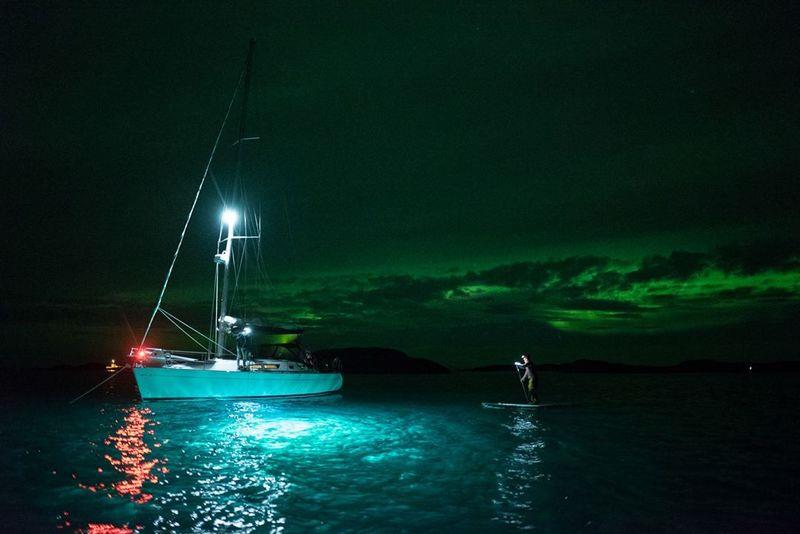
Related Articles
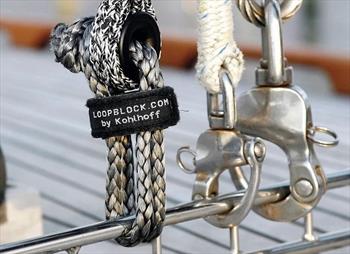
- New Sailboats
- Sailboats 21-30ft
- Sailboats 31-35ft
- Sailboats 36-40ft
- Sailboats Over 40ft
- Sailboats Under 21feet
- used_sailboats
- Apps and Computer Programs
- Communications
- Fishfinders
- Handheld Electronics
- Plotters MFDS Rradar
- Wind, Speed & Depth Instruments
- Anchoring Mooring
- Running Rigging
- Sails Canvas
- Standing Rigging
- Diesel Engines
- Off Grid Energy
- Cleaning Waxing
- DIY Projects
- Repair, Tools & Materials
- Spare Parts
- Tools & Gadgets
- Cabin Comfort
- Ventilation
- Footwear Apparel
- Foul Weather Gear
- Mailport & PS Advisor
- Inside Practical Sailor Blog
- Activate My Web Access
- Reset Password
- Customer Service

- Free Newsletter

Hallberg-Rassy 42 Used Boat Review

Pearson 37 and 37-2 Used Boat Review
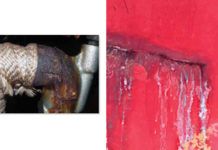
DIY Survey Checklist for Used-Boat Buying
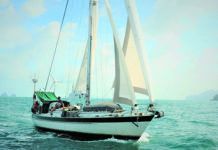
Valiant 40: Reshaping the Cruising Hull

Best Crimpers and Strippers for Fixing Marine Electrical Connectors

Thinking Through a Solar Power Installation

How Does the Gulf Stream Influence our Weather?

Can You Run a Marine Air-Conditioner on Battery Power?

Practical Sailor Classic: The Load on Your Rode

Anchor Rodes for Smaller Sailboats

Ground Tackle Inspection Tips

Shoe Goo II Excels for Quick Sail Repairs
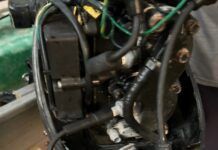
Dinghy Outboard Diagnostics
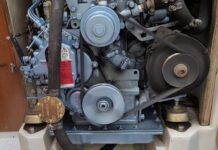
Spring Season Engine Start-Up for Winterized Engines

Solutions for a Stinky Holding Tank

Diesel Performance Additives

Vinyl Boat Lettering DIY Application and Repair

Those Extras you Don’t Need But Love to Have

Hidden Maintenance Problems: Part 3 – Gremlins in the Electrics

Three-Model BBQ Test

Alcohol Stoves— Swan Song or Rebirth?

Living Aboard with an Alcohol Stove

Preparing Yourself for Solo Sailing

How to Select Crew for a Passage or Delivery

Preparing A Boat to Sail Solo

Re-sealing the Seams on Waterproof Fabrics

Chafe Protection for Dock Lines

Waxing and Polishing Your Boat

Reducing Engine Room Noise

Tricks and Tips to Forming Do-it-yourself Rigging Terminals

Marine Toilet Maintenance Tips
- Safety & Seamanship
- Sails, Rigging & Deck Gear
Navigation Lights: Hella and Aqua Signal Shine Brightest
Three of the four major light manufacturers serve up superlative lights-many lights even satisfied coast guard requirements at our engine-off test voltage. still, a variation of the golden rule applies: shine unto others as you would have them shine unto you..
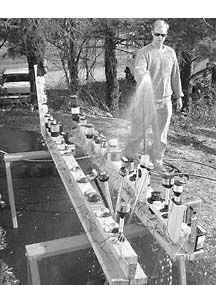
Most boats, new or used, come with navigation lights installed-and that’s about all that we care about them until one of them fails. Sometimes the failure is in the light itself, sometimes in the wiring leading to it. The fix is usually simple enough to perform mechanically or electrically, but there’s an inconvenience factor that varies from minor to major, depending on where the failure occurs. If a light goes out on the bow pulpit or cabinside, it’s no big deal. If it goes out at the top of the mast, it’s a royal pain. After the first of these pains, you begin to pay more attention to how the lights are mounted and sealed against the elements, and how the wiring is led and protected from chafe and crimping. And you begin to consider the design, construction, and materials of the lights themselves.
The other occasional concern we have with these lights is how they actually perform. Again, most of the time we take them for granted-the waters are less crowded at night, tense crossing situations are relatively infrequent, and there’s usually plenty of time to study a developing situation and make a course change if necessary. In times like that, you might feel that you have your lights on just to obey the law, nothing more.
However, when you find yourself negotiating a busy harbor or channel at night, or the visibility isn’t what it could be, or you’re traveling along a shore twinkling with houselights and floodlights and car headlights and all sorts of other distractions, you instantly appreciate running lights that are clear and bright and that stand out against the background-and you wonder just how visible yours are to others.
There are minimal visibility requirements set by the US Coast Guard-see the sidebar on pages 8-9 for the basics. But note that there’s no rule prohibiting a boat from carrying bigger, better lights than those that satisfy the minimum, as long as they don’t shine so brightly or cause so much glare that they interfere with the helmsman’s vision.
Obviously, navigation lights exist to help prevent collisions. As such, they’re important pieces of safety gear. If you suspect the ones aboard your boat are feeble, either in form or function, consider replacing them. It’s to help with your decisions on that score that we’ve done this evaluation.
Light Basics The point of navigation lights underway is to show a 360-degree circle of light at all times, including red and green sidelights, each visible through 112.5 degrees, and a stern light, visible through 135 degrees to complete the circle. On boats under 20 meters, sidelights can be combined in one unit (a bi-color light).
Powerboats underway are required to show sidelights and 360 degrees of white light. The usual configuration is sidelights, a sternlight, and a masthead light. If the boat is under 12 meters in length, an all-round white light can be substituted. The all-round white light also serves as an anchor light, required from sunset to sunrise in areas that are not designated anchorages.
On a sailboat under 20 meters, all three lights can be combined in a tri-color light at the masthead, but only when sailing; under power, a sailboat must show a 360-degree circle of white light, either in an all-around light at the masthead, or in a combination of stern light plus a 225-degree masthead light. (The masthead light is confusingly named, since it’s rarely located at the top of the mast. Usually it’s about three-quarters of the way up. On powerboats it’s usually mounted on a short pole.)
We’re referring here to boats between 7 and 20 meters in length. There are variations on the rules outside that range, but we don’t have enough paper to cover them all.
What Was Tested The last time we tested navigation lights was in 1993-the results were published in the July 1 issue of that year. We evaluated 70 lights then, and as it turns out we looked at 70 lights this time around, too, although there were some variations-missing were lights from Wilcox-Crittenden, which no longer makes them, and Forespar’s ML2 combination masthead/deck light, recommended in ’93 and still on the market (which we forgot). Otherwise we collected all the lights in the major catalogs and chandleries, including individual and bi-color sidelights, tri-color lights, sternlights, masthead lights, and all-round white lights. The lights were represented by four manufacturers-Aqua Signal, Attwood, Hella Marine, and Perko.
How We Tested Our evaluations were simple: All the lights were mounted on pine planks and properly bedded and sealed. On a chilly October night with virtually unlimited visibility, we took the planks to a local beach parking lot with little ambient light around, and set them on sawhorses. With our observer (the keenest-eyed among us) anchored offshore at one nautical mile, we powered each light individually, and the observer called in his impressions via cell phone.

We had noted that the American Boat and Yacht Council (ABYC), in their specs for the Intensity/Nominal Voltage Test for nav lights, says that the test fixture “shall be tested for its ability to meet minimum required luminous intensity… when operated at its intended nominal system voltage. This shall be a single reading at a point selected by the fixture manufacturer.”
That leaves the manufacturers quite a bit of wiggle room to balance bulb characteristics against input voltages in order to achieve their visibility requirements.
We decided to see how the lights would do in less forgiving circumstances. For power we used a truck-mounted 4-D deep-cycle marine battery monitored throughout the test at 12.4 volts-a standing voltage that would approximate power to the lights with the boat’s engine off and the supply battery in reasonably good shape, but with one or two other power demands being made on it at the same time-nav instruments and an interior light or two.
Obviously, with the engine running and an alternator output of 13 volts or more, the lights will shine brighter-so the ratings in our chart should be seen as pessimistic across the board.
After looking at all 70 lights and communicating his ratings at 1 nm, the observer moved out to 2 nm and the whole procedure was repeated. The planks were adjusted as necessary to give the observer the full proper view of each type of light. Occasionally it appeared to the testers on shore that the powered light was mounted close enough to its neighbor that it was picking up an extra reflection. In those cases they inserted a brown clipboard between the lights. It didn’t seem to make much difference.
After the visibility tests, all the lights were sprayed forcefully with a gardenhose and left to sit for two weeks. Then they were sprayed again and checked for continued function. All lights functioned fine after both inundations.
Finally, we studied the lights for quality of construction, mounting methods, and ease of maintenance. Comments on these topics are included in the main chart (see bottom).
We didn’t measure each lens for its required cuto-off angle (e.g. 112.5), reasoning that even if we were persnickety enough to find lights that were a degree or two off either way, such minor anomalies would be of little consequence on the water.
What We Found The chart provides specifics about the lights and our visibility tests. In general, we found that lights met the minimum visibility requirements at 1 mile, with the exception of two red sidelights-the Aqua Signal 22300-1 and the Attwood 3150R7.
Twenty-two lights, nine of which were rated at 2 nautical miles, were invisible at that distance and at our unforgiving voltage. Again, all lights must meet their Coast Guard requirements when powered at the test voltages allowed their manufacturers.
We should note that Hella Marine’s Model 62149 red sidelight, a 3-nm light, is rated to burn a 29-watt bulb at 13 volts, so it was unfairly underpowered in the test. Maybe it’s just for powerboats.
The fit and finish of the lights varied quite a bit, and those variations are often reflected in the price. Only one light, Perko’s Model 170BMD masthead/decklight combination arrived with an obvious flaw-a 4-mm separation in one side of the plastic housing.
A few lights were quite a bit brighter and more visible than the rest of the pack. Only five lights rated good at 2 nm: Aqua Signal’s 40100-1 bi-color light and 40400-1 masthead; Hella Marine’s 62208 stern light, 62206 masthead, and 6225 tri-color. (This tricolor was actually the most visible of all the lights in the test, scoring “excellent” at 1 nm and “good” at 2 nm.)
Some sidelights that were rated for only one nautical mile were still visible at two, even if they were only dimly seen at both distances. Those two achievements-overall brightness and staying power, were, to our minds, the top rating criteria.
See the big chart for further comments. See the recommendations box on page 5 for our picks by light type.
Navigation lights are easy to take for granted, but like so many other bits of safety and navigation gear on a boat, there may eventually come a time when they really need to shine.
Contacts- Attwood, 1016 N. Monroe St., Lowell, MI 49331; 616/897-9241. Hella Marine, 201 Kelly Dr., Peachtree City, GA 30269; 877/224-3552; www.hellana.com . Aqua Signal, 1125 Alexander Court, Cary IL, 60013; 847/639-6412. Perko, Inc., 16490 NW 13th Ave., Miami, FL 33169; 305/621-7525; www.perko.com/ .
Also With This Article Click here to view “Most Visible Lights.” Click here to view “Value Guide: Navigation Lights.” Click here to view “Light Rules.”
RELATED ARTICLES MORE FROM AUTHOR
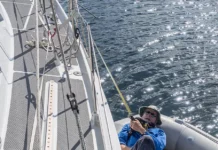
Another Look at Fitting Jacklines
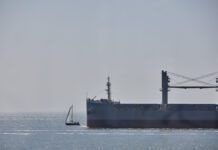
Collision Avoidance When ‘See and Avoid’ Fails
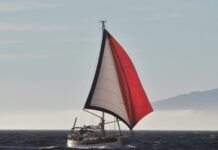
When a Welcome Home Becomes a Rescue
These best boat navigation lights are what most boaters have on their marine vessels for safer and convenient boating trips. I use these bow lights for boat for secured and easy navigation during extreme weather conditions or poor visibility.
Unfortuntately, the links to additional information at the bottom of this article are broken. (Error 404 – not found) Any way to get them fixed?
This may not be the correct location to ask this question about Nav Light placement so please forgive me and direct me if need be. I am mounting a Tri-color light on top of my 26 ft mast. I presently have an under power, “steaming” light on the mast at 11 feet. COLREGS require this forward facing 225 degree white light to be at least 3′ 3″ ABOVE the forward “side markers/lights”. Where do I, or anyone else, mount the steaming light?
LEAVE A REPLY Cancel reply
Log in to leave a comment
Latest Videos

Hanse 410: What You Should Know | Boat Tour

Sailboat vs Fishing Boat – Rules of the Road

Catalina 445: What You Should Know | Boat Review

How to Wax and Polish Your Boat
- Privacy Policy
- Do Not Sell My Personal Information
- Online Account Activation
- Privacy Manager

Please verify you are a human
Access to this page has been denied because we believe you are using automation tools to browse the website.
This may happen as a result of the following:
- Javascript is disabled or blocked by an extension (ad blockers for example)
- Your browser does not support cookies
Please make sure that Javascript and cookies are enabled on your browser and that you are not blocking them from loading.
Reference ID: b8262b25-2eff-11ef-82be-2263228cc718
Powered by PerimeterX , Inc.

- Boat Lights
Boat Navigation Lights

Portable LED Boat Bow Navigation Light w/ Suction Cup
Innovative Lighting Portable LED Boat Bow Navigation Light w/ Suction Cup This Portable LED Boat Bow Navigation Light w/ Suction Cup features molded brass threaded mounting bushings with shock resistant neoprene accents. Rated at 100,00 hours LED...
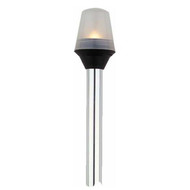
Attwood Frosted Globe All-Round Boat Navigation Light
Attwood Frosted Globe All-Round Boat Navigation Light This Attwood Frosted Globe All-Round Boat Navigation Light uses a standardized lamp that is commonly available in marine, auto, and convenience stores. It provides a 2-mile 360 degree...

Portable Clamp-On Boat Bow and Stern Lights
Attwood Portable Clamp-On Boat Bow and Stern Lights The Attwood Portable Clamp-On Boat Bow and Stern Lights feature a water-resistant, shatterproof polycarbonate lens. They are composed of shock-proof composite housing and have durable, portable LED...

Perko 36" All-Round Boat Navigation Light
Perko 36" All-Round Boat Navigation Light This Perko All-Round Boat Navigation Light helps preserve night vision and provides a reduced glare. With a black polymer top and collars, the amount of light wasted outside of the visibility zone is...

Portable LED Boat Bow Navigation Light For Inflatable
Innovative Lighting Portable LED Boat Bow Navigation Light For Inflatable This Portable LED Boat Bow Navigation Light For Inflatable uses 90% less energy than incandescent bulbs. It is fully buoyant and features shock resistant neoprene accents and...

Attwood Stainless Steel LED Boat Side Light
Attwood Stainless Steel LED Boat Side Light This Attwood Stainless Steel LED Boat Side Light uses LED technology, making it more efficient than standard incandescent bulbs. It keeps the light cooler and draws less power making it a top choice among...

Attwood Bi-Color Boat Navigation Light
Attwood Bi-Color Boat Navigation Light This Attwood Bi-Color Boat Navigation Light is composed of anodized aluminum that raises the light head for visibility above the trolling motor, anchor, or other equipment on the bow. The 14" straight 2-pin...
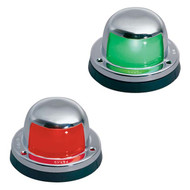
Perko Stainless Steel Boat Side Lights
Perko Stainless Steel Boat Side Lights These Perko Stainless Steel Boat Side Lights feature a black plastic base and a stainless steel top. Sold in pairs, they come with one Starboard (Green) light and one Port (Red) light. They also include a...
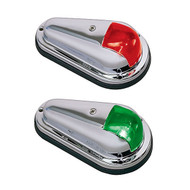
Perko Vertical Mount Boat Navigation Side Lights
Perko Stainless Steel Vertical Mount Boat Navigation Side Lights These Perko Vertical Mount Boat Navigation Side Lights are certified for use on sail or power driven vessels under 12 meters (39.4 ft) in length. They feature both red and green...

Stainless Steel Deck Mount LED Navigation Lights
Stainless Steel Deck Mount LED Navigation Sidelights Innovative Lighting's Stainless Steel Deck Mount LED Navigation Sidelights feature long-lasting LED lights that offer 50,000 hours of service light with a low energy draw. Each sidelight has a...
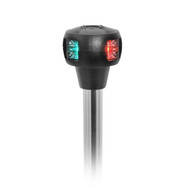
Attwood Bi-Color LED Boat Side Light
Attwood Bi-Color LED Boat Side Light This Attwood Bi-Color LED Boat Side Light features an anodized pole that raises the light head above the trolling motor, anchor or other equipment mounted to the bow. Being completely sealed and...
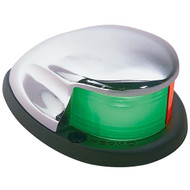
Perko Bi-Color Slant Boat Bow Light w/ Deck Mount
Perko Bi-Color Slant Boat Bow Light w/ Deck Mount This Perko Bi-Color Boat Bow Light w/ Deck Mount features a chrome plated zinc alloy top with a polymer base. It offers one mile of light visibility between 0° - 20° declination as well as a...

Attwood Vertical Boat Transom Navigation Light w/ Flush Mount
Attwood Vertical Boat Transom Navigation Light w/ Flush Mount This Attwood Vertical Boat Transom Navigation Light w/ Flush Mount features a translucent body made up of 304 stainless steel with a plastic body and watertight lamp socket. It provides...

Perko Combo Masthead Boat Navigation Light
Perko Combo Masthead Boat Navigation Light This Perko Combo Masthead Boat Navigation Light features a reduced glare design with a chrome plated Zinc Alloy top. It is certified to be used on sail or power driven vessels under 20 meters (65.6 ft) in...

Attwood Anchor Masthead Boat Navigation Light
Attwood Anchor Masthead Boat Navigation Light - Horizontal Mount This Attwood Anchor Masthead Boat Navigation Light features an easy to grasp cam-lock that stays locked in normal conditions. The cam-lock releases in extreme conditions and allows...

Stainless Steel LED Bi-Color Boat Bow Navigation Light
Innovative Lighting Stainless Steel LED Bi-Color Boat Bow Navigation Light This Stainless Steel LED Bi-Color Boat Bow Navigation Light features polished stainless steel housing with a transparent lens that is cool to the touch. With a 6 LED light...

Attwood Bi-Color LED Boat Bow Light
Attwood Bi-Color LED Boat Bow Light This Attwood Bi-Color LED Boat Bow Light is built to last in even the most extreme saltwater environments with its corrosion resistant design, and reverse polarity protection. With high-quality electro-polished...
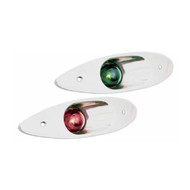
Sea Dog Flush Mount Boat Navigation Side Lights
Sea Dog Flush Mount Boat Navigation Side Lights These Sea Dog Flush Mount Boat Navigation Side Lights are composed of stamped 304 stainless steel that is approved for USCG 1 NM (A-16). They install with four #8 RH fasteners. (Not Included) Sold in...

Portable LED Boat Bow Navigation Light w/ C-Clamp
Innovative Lighting Portable LED Boat Bow Navigation Light w/ C-Clamp This Portable LED Boat Bow Navigation Light w/ C-Clamp is fully buoyant and rated at 100,000 hours of LED service life. Constructed of a molded one piece white body construction...

Perko "Classic" Combination Boat Bow Navigation Light
Perko "Classic" Combination Boat Bow Navigation Light This Perko "Classic" Combination Boat Bow Navigation Light features chrome plated zinc alloy with a flag staff socket. It comes with a Starboard (green) and Port (Red) light with red/green...
Boat Navigation Lights: Safety with the flick of a switch
When visibility on the water is low, ensure that you have the right marine navigation lights installed from Wholesale Marine. From yachts, to cruisers, small boats, PWC's or even kayaks we offer a variety of portable navigation lights.
Boat stern lights offer a bright white light for visibility on the water. Stern lights come in a variety of mounting options, the two most common are a mounted fixed light or a drop in light on a pole. Boat side lights come in a starboard side (green) and port side (red) light. You can mount a separate light on either side, or use a bi-color light that contains both. If your vessel meets the requirements, you can always use a tri-color light that combines both stern and side lights.
The size of your vessel determines the United States Coast Guard navigation light requirements you must meet. The requirements are for either a main masthead or sternlight head with a pair of side lights. The lights are required to meet a certain nautical distance shine from dead ahead.
Boats that are less than 39.4’ (12 meters) require sidelights with visibility up to 1 nautical miles and a white stern light up to 2 nautical miles.
Boats that are less than 65.7’ (20 meters) require sidelights with visibility up to 2 nautical miles and a masthead light up to 3 nautical miles.
Boats over 65.7' and less than 164' (20 meters - 50 meters) require sidelights with visibility up to 2 nautical miles and a masthead light up to 5 nautical miles.
Whether you’re searching for bow lights or side lights, Wholesale Marine stocks trusted marine brands including Attwood , Perko Marine , and Innovative Lighting . Find reliable boat navigation lights for every type of water vessel.
Marine Navigation Lights That Meet Requirements
Whether you’re piloting a small fishing boat or large power boat, trust that Wholesale Marine has the right boat navigation lights for you. As you are equipping your boat, it is important to be mindful of navigation light requirements for your style of boat. Power driven vessels are required to have a stern light , and either a pair of side lights or a bow light.
Perko Marine side lights such as the Perko Vertical Mount Side Light are equipped with red and green marine navigation lights. Gold-plated contacts provide excellent conductivity while holding up against normal wear.
Depending on your application, you may opt-out of boat side lights in favor of a bi-color deck light. Bi-color deck lights, like the Attwood Bi-Color Boat Navigation Light , function the same as a side light, but feature red and green lights contained in a single unit. This bi-color dual side light offers a universal fit, sitting on a 14” straight 2-pin locking collar pole.
Increase your visibility on the water with the Attwood LED All-Round Boat Stern Light . This boat stern light offers bright white light and is designed for 360° visibility on boats up to 39.4' in length. This marine navigation light is one of many that we stock that is US Coast Guard Approved for 2 nautical miles.
When your boat is anchored, you are required to use a 360° anchor light that is visible up to 2 nautical miles. A perfect choice is the Attwood LED Anchor light . Constructed from enhanced 316 stainless steel and corrosion resistant alloys, this navigation light is designed to hold up. The powerful LED’s are rated for over 50,000 hours of use and produce a light bright enough to be seen up to 3 nautical miles away.
For ease of operation, we recommend Innovative Lighting’s Portable LED Stern Navigation Light . It features a suction cup mount that attaches virtually anywhere, and its rugged construction is able to withstand even tough marine environments. Many of our portable navigation lights for boats use LED bulbs, which consume less power and have a longer service life than regular incandescent or halogen bulbs.
Choosing the Right Boat Navigation Lights
Trying to decide between different marine navigation lights? Our customer service team is composed of boat enthusiasts that are eager to offer real-world advice on the boat navigation lights. We would be more than happy to help you get the light best suited for your boat and boating activities. We’re here for you Monday through Friday from 8:30 AM until 4:30 PM. Sign up for our Captain’s Club Rewards Program to accrue points for extra savings the next time you shop at Wholesale Marine!
Subscribe to our Newsletter
Get the latest updates on new products and upcoming sales
Oops, something went wrong. Please try again.
You are now logged in!

Best Sellers in Boat Navigation Lights

- ← Previous page
- Next page →

- Amazon Newsletter
- About Amazon
- Accessibility
- Sustainability
- Press Center
- Investor Relations
- Amazon Devices
- Amazon Science
- Sell on Amazon
- Sell apps on Amazon
- Supply to Amazon
- Protect & Build Your Brand
- Become an Affiliate
- Become a Delivery Driver
- Start a Package Delivery Business
- Advertise Your Products
- Self-Publish with Us
- Become an Amazon Hub Partner
- › See More Ways to Make Money
- Amazon Visa
- Amazon Store Card
- Amazon Secured Card
- Amazon Business Card
- Shop with Points
- Credit Card Marketplace
- Reload Your Balance
- Amazon Currency Converter
- Your Account
- Your Orders
- Shipping Rates & Policies
- Amazon Prime
- Returns & Replacements
- Manage Your Content and Devices
- Recalls and Product Safety Alerts
- Conditions of Use
- Privacy Notice
- Consumer Health Data Privacy Disclosure
- Your Ads Privacy Choices
WRIC ABC 8News
A ship found far off Israel’s coast could shed light on the navigation skills of ancient mariners
by: MELANIE LIDMAN, Associated Press
Posted: Jun 20, 2024 / 05:58 AM EDT
Updated: Jun 20, 2024 / 05:58 AM EDT
TEL AVIV, Israel (AP) — A company drilling for natural gas off the coast of northern Israel discovered a 3,300-year-old ship and its cargo, one of the oldest known examples of a ship sailing far from land, the Israel Antiquities Authority said Thursday.
The discovery of the late Bronze Age ship so far out at sea indicates that the navigation abilities of ancient seafarers were more advanced than previously thought because they could travel without a line of sight to land, the IAA said.
The great depth at which the ship was found means it has been left undisturbed by waves, currents or fishermen over the millennia, offering greater potential for research, it said.
“The discovery of this boat now changes our entire understanding of ancient mariner abilities. It is the very first to be found at such a great distance with no line of sight to any landmass,” said Jacob Sharvit, head of the IAA marine unit, adding that two similar ships from the same era had been discovered previously, but only close to shore.
Sharvit said the assumption by researchers until now has been that trade during that era was conducted by boats sailing close to the shore, keeping an eye on land while moving from port to port. He said the newly discovered boat’s sailors probably used the sun and the stars to find their way.
The wooden ship sank about 90 kilometers (55 miles) off Israel’s Mediterranean coast and was discovered at a depth of 1,800 meters (1.1 miles) by Energean, a natural gas company which operates a number of deep-sea natural gas fields in Israel’s territorial waters.
In its work, Energean said it uses a submersible robot to scour the sea floor. About a year ago, it came across the 12 to 14 meter (39 to 45 foot) -long ship buried under the muddy bottom, nestled under hundreds of jugs that were thousands of years old.
The boat and its cargo were fully intact, the IAA said, adding that the vessel appeared to have sunk either in a storm or after coming under attack by pirates.
The ship for now is not being retrieved.
Energean worked with the IAA to retrieve two of the jugs, which were likely used for carrying oil, wine or fruit, and bring them to the surface for research.
The IAA identified the jugs as Canaanite, a people who resided in the lands abutting the eastern Mediterranean.
Trending Stories
‘it’s bittersweet’: attorneys weigh in after a richmond …, virginia primary election results for june 2024 — …, six juveniles arrested in connection to over 25 motor …, watch abc 8news newscasts, stormtracker 8: summer heat today; intense heat tomorrow …, experts warning virginians about poisonous carrot-like …, one of 2 chesterfield caretakers set to appear in …, virginia’s 5th district gop primary between bob good …, tempers flare as richmond school board members discuss …, hanover resident fighting for life after firefighters ….
Thanks for signing up!
Watch for us in your inbox.
Subscribe Now
StormTracker8 Severe Weather Alerts
Local events.
Structured data
Items portrayed in this file, 31 august 2007, source of file, original creation by uploader, image/svg+xml, a40fce78c48333073766c67e926dbd360cea4343, 38,005 byte.
- Coats of arms of cities and villages of Moscow Oblast
- Culture of Elektrostal
- Hephaestus in heraldry
- Hammers sable in heraldry
- 2 flashes Or in heraldry
- Atom symbols in heraldry
- SVG coats of arms of Russia
- PD-RU-exempt (coats of arms)
Navigation menu
Project Pride SRQ plans to ‘light the bridge’ in its own way after state decision canceled display
by: Allyson Henning
Posted: Jun 19, 2024 / 05:21 PM EDT
Updated: Jun 19, 2024 / 05:21 PM EDT
SARASOTA, Fla. (WFLA) — Pride Month is in full swing throughout the City of Sarasota. Rainbow banners can be seen hanging off light posts along Main Street and there’s a Pride flag flying outside city hall.
The most prominent bridge in the city, however, is not illuminated in rainbow colors as we’ve seen in the past three years.
In early May, a Florida Department of Transportation official announced all Florida bridges would be illuminated in red, white and blue from Memorial Day through Labor Day, in recognition of what’s being called the state’s “Freedom Summer” celebration.
The decision to stick with patriotic colors for the summer canceled light displays planned for Pride, Juneteenth, Gun Violence Awareness and other awareness days, which caused controversy not just in the Tampa Bay area, but across the state.
“My question would be why? What is it? What is the motivating factor to not allow certain groups to have representation,” questioned President of Project Pride SRQ Jason Champion.
An FDOT spokesperson sent News Channel 8 the following statement.
“FDOT made the decision to light state-owned bridges, red, white, and blue from Memorial Day to Labor Day to celebrate America. FDOT supports the Governor’s vision to encourage Floridians to enjoy the activities and attractions that Florida has to offer while celebrating the liberties and freedoms that so many fought for us to have. In that spirit, we are happy to honor our country with this lighting display.”
“The decision to have a “Freedom Summer” is something that we all agree in. We live in one of the greatest countries in the world and we appreciate and love our freedom and our service people that fought for that freedom, but with that freedom, we also have representation of all groups that are out there,” said Champion.
Project Pride SRQ is planning a march for the John Ringling Causeway.
“We decided to light the bridge in our own way by having the representation of our flag, all 700 feet of it going over the Ringling Bridge on June 29th,” said Champion.
The walk is set to begin at 9 a.m. on Saturday, June 29.
The local organization claims to have the largest Progressive Pride flag in the nation and says it will be on full display at the end of the month.
“Our movement for quality is not just about LGBTQ+ rights. It is about racially quality, it is about gender equity, and throughout history, the most successful movements for equity have been diverse coalitions. We are trying to invite everyone underneath our tent and just sustain that really vibrant and diverse community,” said Project Pride Executive Director Paul Lotierzo.
The group has already gathered around 1,000 signatures in a petition to bring back the Pride bridge light display for next year. They hope to bring that before state leaders in the months to come.
“We are not going anywhere and we are going to keep showing up for each other and supporting each other, so I would invite them to come down and see what that joy really looks like, maybe change some hearts and minds, one at a time,” said Lotierzo.
Flattering and trendy one-piece swimsuits for curvy …
Whatever you’re looking for in a swimsuit this season, these one-piece styles will have you ready for lounging beachside or lapping the pool.
These pool sandals will help you avoid slips and …
Sandals that are made to withstand exposure to water and have dependable traction will prevent slips. Here are the best sandals to wear to the pool this summer.
Get Sonic-style ice at home with these nugget ice …
With one of these nugget ice makers, you can have Sonic-quality ice at home whenever the mood strikes.
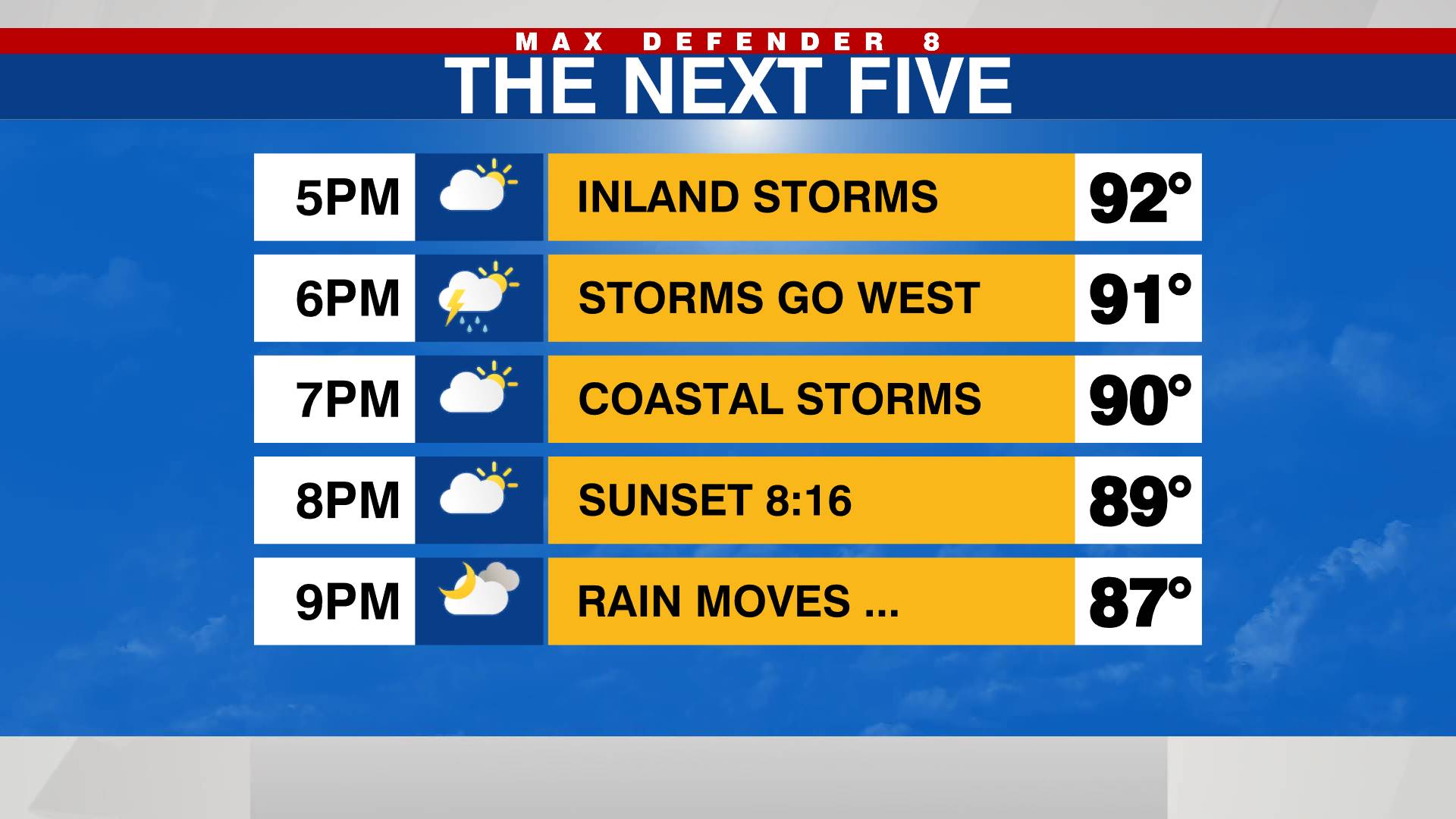
BestReviews.com - Top picks to make everyone happy
Best prime day home deals 2024, our diy expert weighs in on the best father’s day …, best prime day electronics deals 2024, best prime day kitchen and cookware deals 2024, last-minute father’s day gifts, tested and reviewed, cool gifts for dad he’ll love this father’s day.
Thanks for signing up!
Watch for us in your inbox.
Subscribe Now
Breaking News
Trending stories, fl rep. calls on osha to make heat protection rules, pasco county community holds vigil for missing family, pasco man shot while riding motorcycle, nhc tracks t.s. alberto, 2 other tropical waves, watch: bull sharks spotted circling in tampa bay, why you shouldn’t drink coffee right after waking …, man has been impersonating officers for a decade: …, young gator spotted ‘gaping.’ what does it mean.

Weather App

LIST: Juneteenth events happening in Tampa Bay
Margaritaville-themed cruise ship makes its first …, metropolitan ministries in need of donations, the best deals for tampa bay restaurant week, jimmy buffett’s daughter helps welcome new ship to ….
| |||||||||||||||||||||||||||||||||||||||||||||||||||||||||||



IMAGES
VIDEO
COMMENTS
As such a power boat, and by extension all sailboats, MUST, without question show one green light on the starboard bow and one red light on the port bow and one all around white light or lights while operating in reduced visibility. These lights should shine at all 360 degrees of visibility with the bow lights shining at an angle of dead ahead ...
On any vessel, navigation lights have a specific color, (white, red, green, yellow, blue), arc of illumination, range of visibility, and location, as required by law and regulations. For the purposes of this course, we will concentrate on pleasure boats under 65 feet in length. Knowledge of navigation lights is important to a small-boat skipper ...
For most small vessels, motoring requires red and green (port and starboard) lights, and a white light visible in all directions around the boat. This is almost always a stern light and a masthead light on sailboats. Boats under sail require port and starboard lights, and a white stern light. Sailboats below sixty-five feet may show a tricolor ...
Powerboat under 23 feet (7m) Powerboats under 23 feet are required to have the following navigation lights displayed: One white masthead light visible for 2 miles. One red & green sidelight visible for 1 mile. One stern light visible for 2 miles. One white, red, green, or yellow all-round light visible for 2 miles.
A vessel that is over 7 m or 23 ft in length is expected to show red and green sidelights when sailing. Each of these lights needs to cover an arc of 112.5°. The sidelights may be combined in one lantern at the bow when below 25 m or 65 ft. The white stern light can be seen over an arc of 135°.
These lights play essential roles in identifying the ship's length, direction, and purpose! The colored marker lights and where to find them go as follows: The boat's port side is marked with a red light. The starboard side light is green. When looking at the boat's transom or stern, a white light may be visible.
The basic rule is that sidelights and a stern light are required. Permissible variations to this rule appear below. Sailboats less than 20m (65.7') can substitute a tricolor light for separate sidelights and stern light—or a bi-color light and a stern light may be substituted. Sailboats less than 7m (23') shall, if practicable, exhibit lights ...
Vessel length: 12 meters to 20 meters (39.4 FT. to 65.6 FT.) Lighting requirement: A white masthead light located at the front of the boat, pointing in the direction you are traveling. This must be visible at 225 degrees and from two miles away. The masthead light must be positioned at least 8 feet above the gunnel.
Attwood 14190 Boat Navigation Lights. Kitting out your boat with all the needed lights doesn't have to involve buying several products. These lights come with red and green navigation lights, a white LED stern light, hardware, a pole, and a C-clamp for simple mounting. In addition, each light is battery-powered with a shatterproof ...
Types of Navigation Lights. Masthead Light: This is a white light with a 225-degree arc, placed at the highest point of the boat. This serves as the primary light for other boats to identify your vessel's position. The masthead light is a white light that must be visible for at least 2 miles. Stern Ligh t: This white light is placed at the ...
==Short answer sailboat navigation lights:== Sailboat navigation lights are essential safety features that help vessels communicate and avoid collisions at night. These lights, such as the red and green sidelights and white stern light, allow sailors to determine the direction and status of approaching boats. Understanding the Importance of Sailboat Navigation LightsUnderstanding the Importance of
As a seasoned boater or a seafaring enthusiast, your understanding of marine navigation lights can make a vast difference in your nocturnal and low-visibility voyages.Precision in navigating the open waters lies not only in skill but also in the silent language of luminescence, communicated through the boat navigation lights.Whether adrift at twilight or in the embrace of a foggy morning ...
The COLREGS state that the steaming light, on a vessel between 12m - 20m must have a range of at least 3nm, therefore the Lopolight 3nm Masthead light is a great choice. Stern Light - Lopolight 2nm stern. The stern light has an arc of 135 degrees and is used when a sailing vessel is motoring.
Practical Sailor' s previous evaluations of navigation lights (September 2005 and Jan. 15, 2002) were tests of tri-color Photos by Ralph Naranjo. 288. masthead lights, sidelights, sternlights, and all-around white lights. For this review, we narrowed the test field and focused solely on LED tri-color navigation lights (sidelights and a stern light combined in a single fixture) because of the ...
206-632-4462. Email. Boat Navigation Lights - 2 NM NaviLED 360 PRO - All Round White C-5 Navigation Lamps - 2 NM NaviLED 360 Compact All Round C-5 LED Lamp - 3 NM Masthead light.
Only five lights rated good at 2 nm: Aqua Signal's 40100-1 bi-color light and 40400-1 masthead; Hella Marine's 62208 stern light, 62206 masthead, and 6225 tri-color. (This tricolor was actually the most visible of all the lights in the test, scoring "excellent" at 1 nm and "good" at 2 nm.) Some sidelights that were rated for only ...
exterior lighting. navigation lights. CONTACT WEST MARINE. Live Chat. 1-800-262-8464. Store Locator. Shop navigation lights at West Marine including port and stern LED lights, deck and side mounted lights and more. Get free shipping to home or in-store!
This bi-color dual side light offers a universal fit, sitting on a 14" straight 2-pin locking collar pole. Increase your visibility on the water with the Attwood LED All-Round Boat Stern Light. This boat stern light offers bright white light and is designed for 360° visibility on boats up to 39.4' in length. This marine navigation light is ...
Boaton Marine Boat Navigation Lights, Night Fishing No Drilling Install Bow Lights Running For Pontoon Bass Jon Jet Ski Kayak. 2,851. 1 offer from $14.99. #7. marinexplore Boat Anchor Light,White LED Stern Light for Boat 3 Nautical Mile Bimini Top Lights Fold Down Pontoon Light All Round 12~24V, 6''.
TEL AVIV, Israel (AP) — A company drilling for natural gas off the coast of northern Israel discovered a 3,300-year-old ship and its cargo, one of the oldest known examples of a ship sailing far ...
596K subscribers in the vexillology community. A subreddit for those who enjoy learning about flags, their place in society past and present, and…
Jump to navigation Jump to search. File; File history; File usage on Commons; File usage on other wikis; Size of this PNG preview of this SVG file: 474 × 581 pixels. Other resolutions: 196 × 240 pixels | 392 × 480 pixels | 626 × 768 pixels | 835 × 1,024 pixels | 1,671 × 2,048 pixels.
We checked out the 136-passenger Sea Cloud Spirit on a Mediterranean cruise. In this era of gargantuan ships, its elegant clipper design, wooden decks and relatively small size stands out.
Thousand-year-old DNA from Chichén Itzá offers eye-opening details of the religious rituals of ancient Maya. By Freda Kreier In the spring of 1967, workers building a small airport behind ...
The walk is set to begin at 9 a.m. on Saturday, June 29. The local organization claims to have the largest Progressive Pride flag in the nation and says it will be on full display at the end of ...
A new era of science at the Advanced Photon Source (APS) is ready to begin.On June 17, 2024, the facility at the U.S. Department of Energy's (DOE) Argonne National Laboratory delivered its first X-ray light beams to a scientific beamline as part of a comprehensive and complex upgrade.The APS, a DOE Office of Science user facility, has been a leading destination for X-ray science for nearly ...
Likino-Dulyovo Tourism: Tripadvisor has 61 reviews of Likino-Dulyovo Hotels, Attractions, and Restaurants making it your best Likino-Dulyovo resource.
Heliport information about UUDO - Orlovo, MOS, RU. Information on this site may not be accurate or current and is not valid for flight planning or navigation.
While companies say they champion diversity, there are glaring disparities in diverse representation within managerial ranks. The authors examine the impact of various management practices on ...
There were no trees. There was no road. I was the trees, and I was the road. That darkness was like no darkness I've ever known.